Special Report
The Best City to Be Single in Every State

Published:
Last Updated:

Tying the knot is for many people one of the most prominent milestones of adult life — but not for all. While marriage provides many advantages — such as tax breaks — fewer Americans are choosing to get married. Those who do choose to stay single, remain single longer compared with previous generations. Many other Americans are single for other reasons.
There are more than 160 million single Americans — divorced, widowed, separated, or those who have never married — or approximately 51.0% of the U.S. population. Most of this group consists of people who have never been married.
To find the best city for singles in every state, 24/7 Tempo reviewed for all U.S. metro areas the percentage of the adult population that is single, the concentration of businesses such as restaurants and bars, and income levels. The best cities for singles are home to a relatively large number of unattached people, have plenty of amenities supporting social interaction, as well as a local economy that is conducive to financial independence.
Specifically, single people in these cities tend to be the majority of the adult population. The cities where this is not the case, but are still considered best for singles, are either especially affordable, or have high concentrations of social venues such as bars and restaurants. Of the 50 best cities for singles, 37 have a cost of living that is lower than the average nationwide.
Since the 1950s, the age at which people have taken their marriage vows in the United States has steadily risen. Census Bureau statistics note that the median age of first-time brides and bridegrooms hovered around 20 in the 1950s. Now, that benchmark is nearly 30 — and it seems to be gradually going up. Here are the states where people marry older.
Click here to see the best city for singles in every state
Click here to see our detailed methodology

1. Alabama: Auburn-Opelika
> Population: 159,287
> Single population: 56.2% of total population
> Cost of living-adjusted income: $48,621 per capita
> Cost of living: 15.6% less than the national average
Many cities on our list are not large areas by population but made the cut partially because the majority of residents are unmarried. Auburn-Opelika is one such city. It is not a major metro area in Alabama, with only about 160,000 residents, but 56.2% of the adult population is single. Plus, there are plenty of places to go on a date. The number of snack bars and restaurants per capita in Auburn-Opelika exceeds the average per capita for the state.
[in-text-ad]
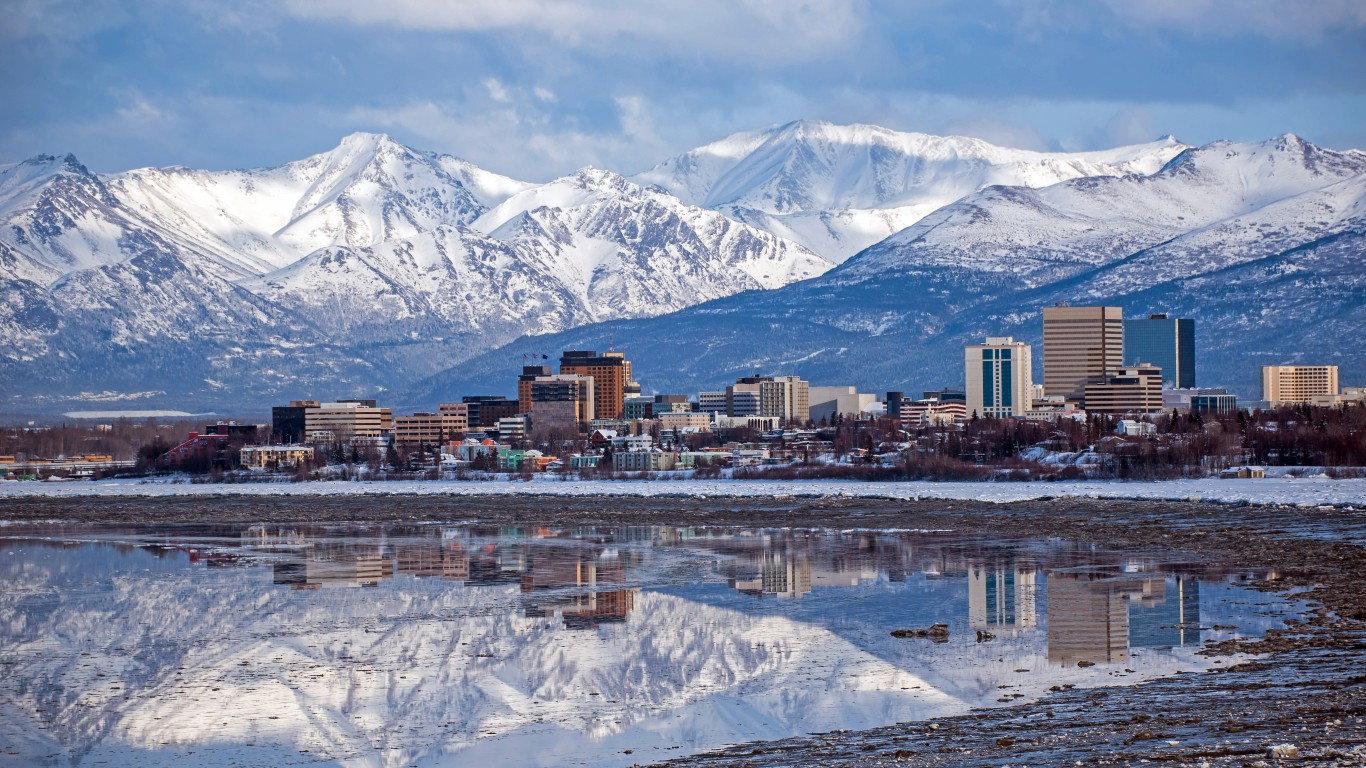
2. Alaska: Anchorage
> Population: 399,576
> Single population: 51.0% of total population
> Cost of living-adjusted income: $47,396 per capita
> Cost of living: 7.9% greater than the national average
Anchorage, one of two metropolitan statistical areas in Alaska as defined by the Census Bureau, is not cheap. Both the cost of living and the average cost of a date are among the highest in the country. But so is the median household income at almost $82,000, compared with a U.S. median of $62,000. Plus, unlike residents in many other cities where residents spend much of their income on rent, Anchorage’s residents spend just a third of their income on rent, leaving some disposable income for savings or fun activities for people who prefer to be alone as well as those looking for date ideas.
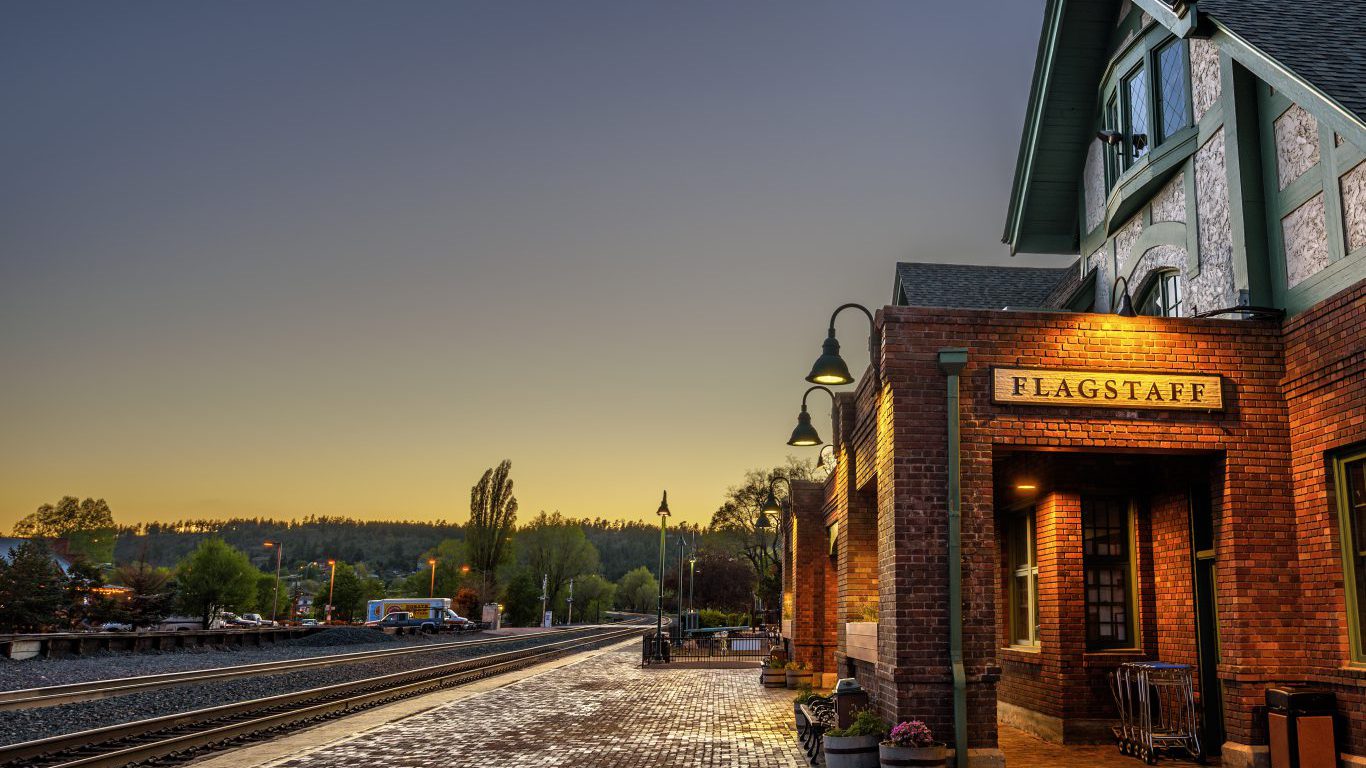
3. Arizona: Flagstaff
> Population: 140,217
> Single population: 60.4% of total population
> Cost of living-adjusted income: $45,330 per capita
> Cost of living: 1.1% less than the national average
Single people — whether they look for date ideas or a place to have fun on their own — won’t be bored in Flagstaff. The city is surrounded by mountains, pine forests, and even a desert, all of which create many opportunities for outdoor activities. Flagstaff also has 25 amusement and recreational facilities per 100,000 people, about six times the state’s average of four amusement and recreational facilities per 100,000 people.
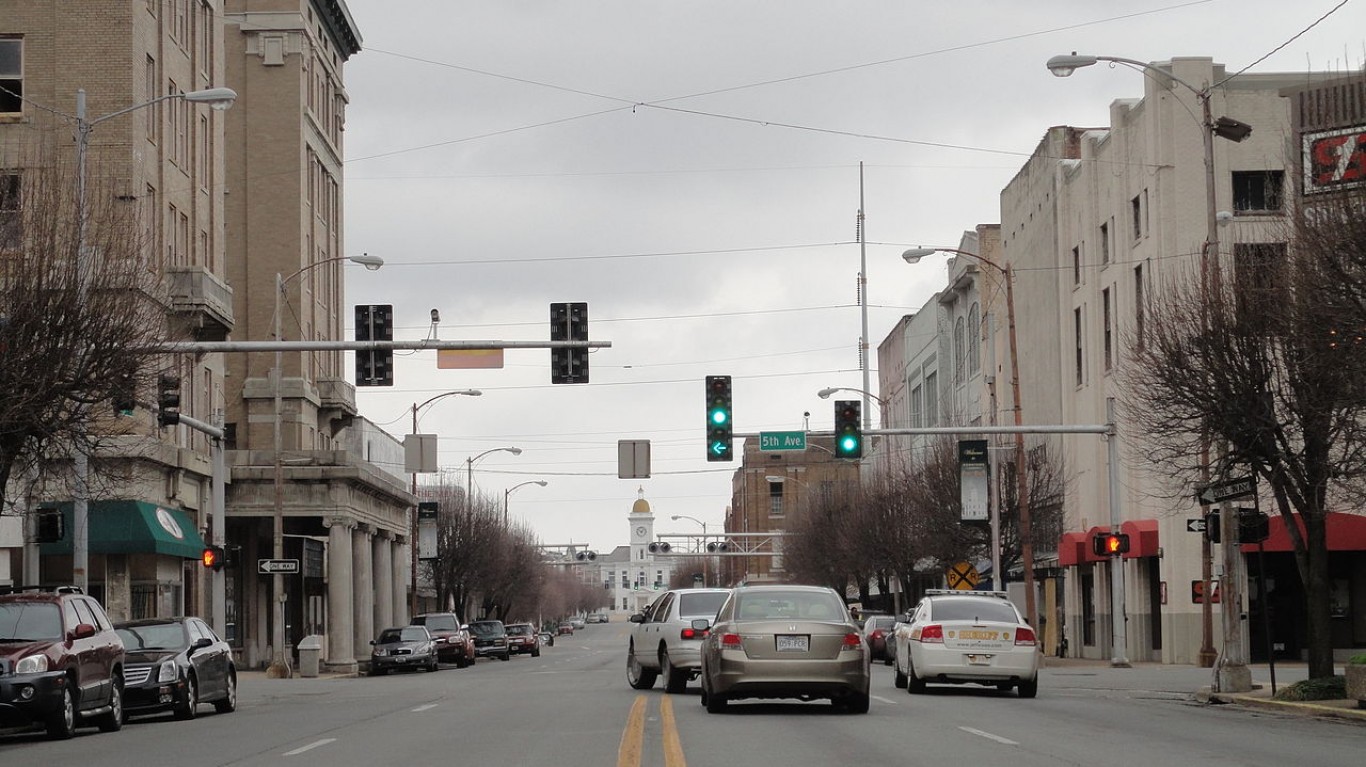
4. Arkansas: Pine Bluff
> Population: 92,345
> Single population: 58.3% of total population
> Cost of living-adjusted income: $46,064 per capita
> Cost of living: 17.2% less than the national average
While Pine Bluff isn’t experiencing a population growth — in fact, the metro area’s population declined by about a fifth since 2000 — the majority of the residents (58.3%) are either never married, divorced, widowed, or separated. The cost of living is 17.2% lower than the national average, and lower than the state average, which means that people have extra money to spend on movies, restaurants, amusements parks, and other places of entertainment.
[in-text-ad-2]

5. California: Santa Maria-Santa Barbara
> Population: 443,738
> Single population: 55.1% of total population
> Cost of living-adjusted income: $47,165 per capita
> Cost of living: 9.6% greater than the national average
The Santa Maria-Santa Barbara area is one of the more popular regions in California for tourists, but it’s also a nice place to call home, especially if you like to go out. Single residents — whether unmarried, widowed, divorced or separated — make 55% of the adult population. Though the cost of living is higher than the national average by 9.6%, it is lower compared with the average for the state of California.
6. Colorado: Boulder
> Population: 321,030
> Single population: 53.6% of total population
> Cost of living-adjusted income: $55,730 per capita
> Cost of living: 8.7% greater than the national average
The population of unmarried residents in Boulder, a city at the foothills of the Rocky Mountains, is 53.6%. More people continue to move there. About 45% of the total population are people between 15 and 44 years old, a prime dating age. People who aren’t looking for a partner have plenty to do as well. Boulder has more snack and non-alcoholic bars, restaurants, recreational sports centers, and museums per 100,000 people than the state average.
[in-text-ad]
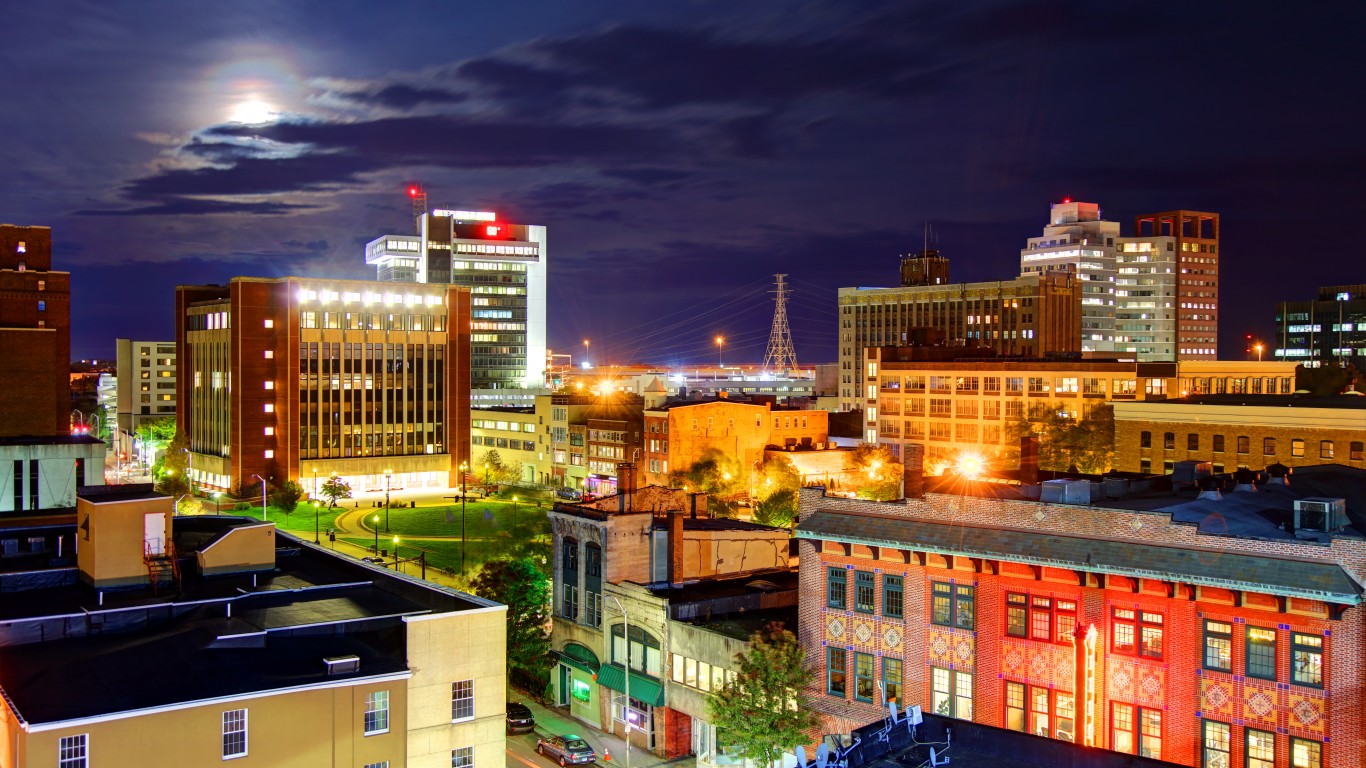
7. Connecticut: Bridgeport-Stamford-Norwalk
> Population: 944,348
> Single population: 48.8% of total population
> Cost of living-adjusted income: $75,548 per capita
> Cost of living: 19.1% greater than the national average
Like Connecticut as a whole, the Bridgeport metro area is one of the most expensive places in the United States. The area’s high incomes, however, more than offset the high costs, helping those who wish to lead a single lifestyle more easily achieve financial independence.
The area’s single population — those who have never married, divorced, separated, or widowed — is relatively small compared with the best place to be single in most states, at 48.8%. But for single Americans living in the area looking for dates or activities to do alone, there are plenty of options. Museums, parks, spectator sports, and exercise venues are all more concentrated in the metro than both the state and national averages.
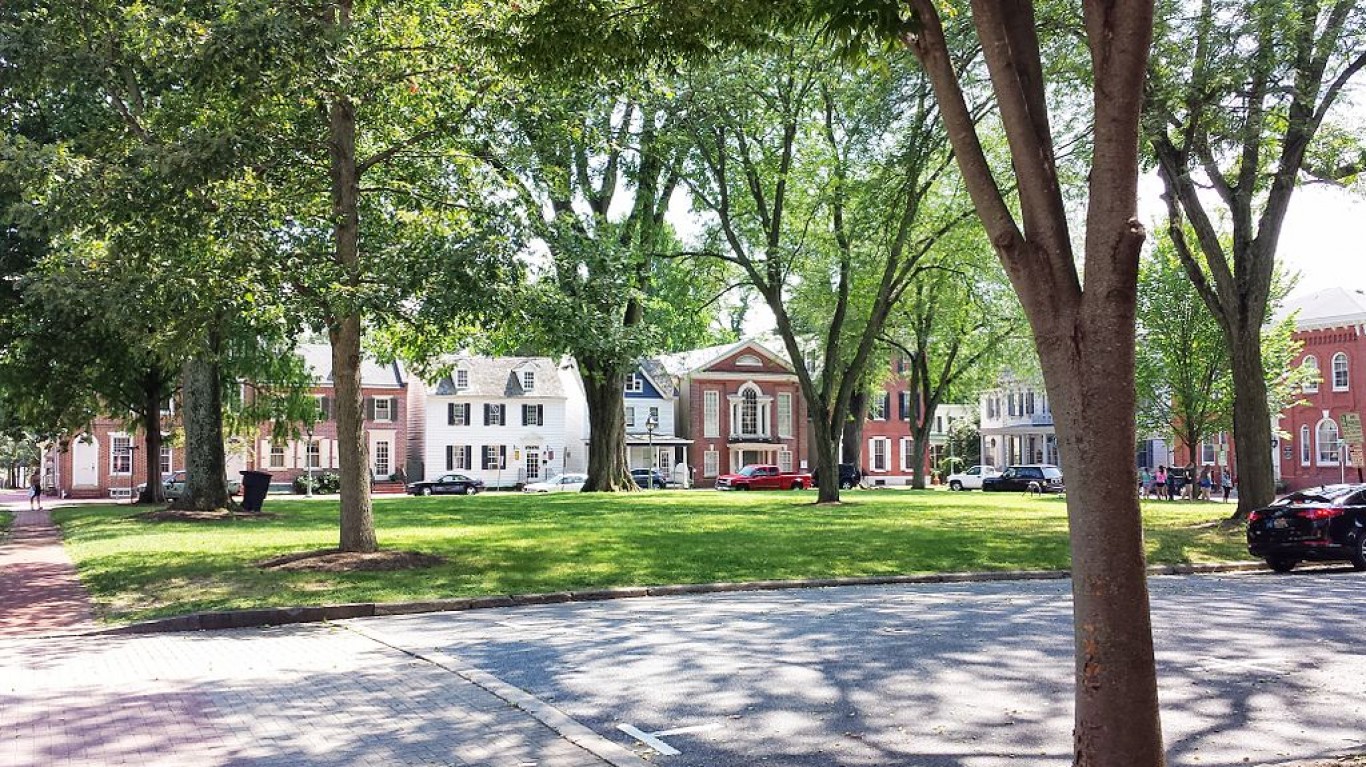
8. Delaware: Dover
> Population: 174,822
> Single population: 52.3% of total population
> Cost of living-adjusted income: $44,138 per capita
> Cost of living: 6.7% less than the national average
As the only metropolitan statistical area in Delaware, Dover is the best city in the state for singles by default. Still, even without any competition, Dover has notable indicators that are favorable to single residents. The city’s single population, at 52.3% of adults, is above the national average. While per capita income in the area is lower than in most states, the average cost of goods and services is 6.7% lower than prices nationwide. And, for sports fans looking for date options, Dover has plenty: the concentration of spectator sports in Dover is the 13th of any metropolitan area in the country.
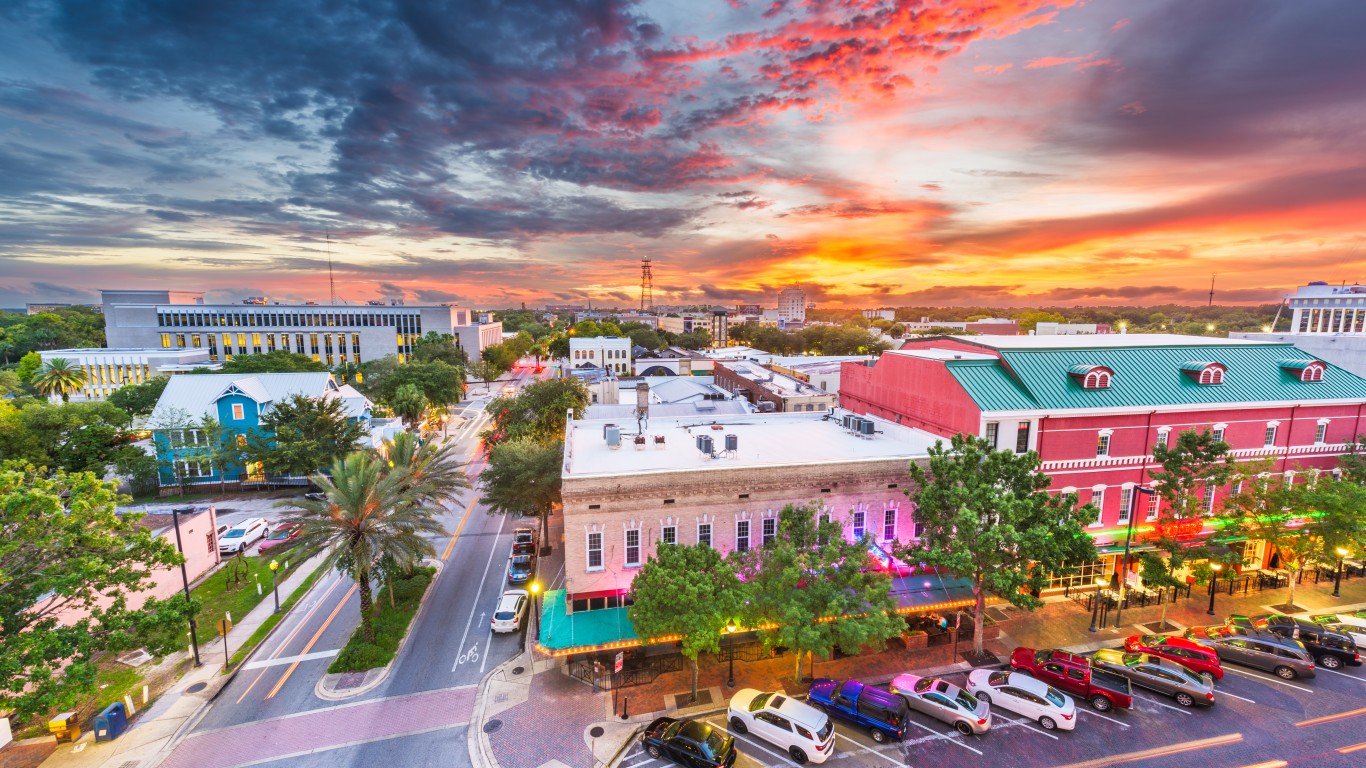
9. Florida: Gainesville
> Population: 280,763
> Single population: 62.7% of total population
> Cost of living-adjusted income: $43,857 per capita
> Cost of living: 5.8% less than the national average
If a smaller metro area somewhat off the beaten path sounds like a nice place to live, Gainesville may be a good option. Around 62.7% of the city’s population is unmarried, which is not all that surprising considering that a large portion of the population are college students. (Gainesville is mostly known as being home to the University of Florida.) Living in Gainesville is cheaper than the rest of the state, with housing costs making up about a quarter of people’s income.
[in-text-ad-2]

10. Georgia: Albany
> Population: 153,101
> Single population: 59.4% of total population
> Cost of living-adjusted income: $50,741 per capita
> Cost of living: 17.3% less than the national average
Albany, known for being musician Ray Charles’ hometown, is one of few metro areas on our list where the unmarried or separated population is significantly over half. The cost of living in Albany, located in southwest Georgia, is much lower than both the state and national averages. The city’s location on the Flint River makes it a good place for outdoor adventures that single people can enjoy both on their own and on dates.
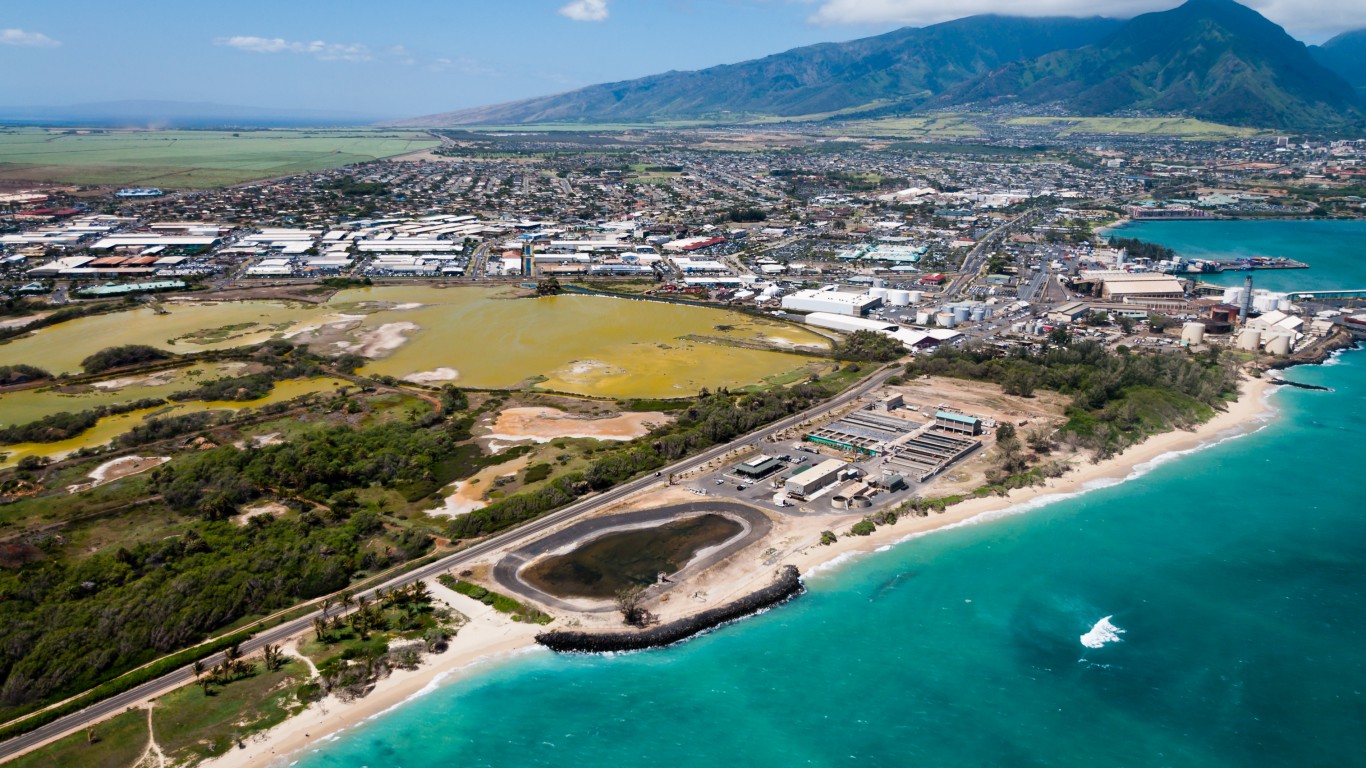
11. Hawaii: Kahului-Wailuku-Lahaina
> Population: 165,356
> Single population: 50.2% of total population
> Cost of living-adjusted income: $39,060 per capita
> Cost of living: 7.3% greater than the national average
Kahului-Wailuku-Lahaina is one of two metropolitan statistical areas in the state of Hawaii. The unmarried population is barely more than half, but the metro area offers many benefits that single householders, which represent about a fifth of all occupied housing units, can enjoy. They include dinner theaters, museums, zoos and botanical gardens, amusement and recreation establishments, all of which are more concentrated in Kahului-Wailuku-Lahaina than the rest of the state.
[in-text-ad]

12. Idaho: Lewiston
> Population: 62,492
> Single population: 48.9% of total population
> Cost of living-adjusted income: $50,208 per capita
> Cost of living: 9.0% less than the national average
The best place for singles in Idaho turns out to be a metro area that includes a county from neighboring Washington. The Lewiston, ID – WA metropolitan statistical area comprises Nez Perce County, Idaho, and Asotin County, Washington. The area is one of the few places ranked as best for singles in their respective states where the share of unmarried residents is less than half, though the population has been increasing over the years. What may encourage people to move there is the cost of living. It is lower than both the state and national averages, and housing costs are just a fifth of a person’s monthly income, leaving plenty of disposable income for recreational activities, savings, or other spending.

13. Illinois: Danville
> Population: 78,407
> Single population: 54.6% of total population
> Cost of living-adjusted income: $57,134 per capita
> Cost of living: 21.1% less than the national average
Danville may not be located near a major city in Illinois or even neighboring Indiana, but it has a large pool of single, divorced, separated or widowed residents. Single and married residents alike benefit from the low cost of living in the metro area. It is 21.1% lower than the national average and significantly lower than the state average. Locals may enjoy bowling, a popular activity for both dates and having fun with friends, as Danville has more than double the number of bowling centers per 100,000 people than the rest of the state.
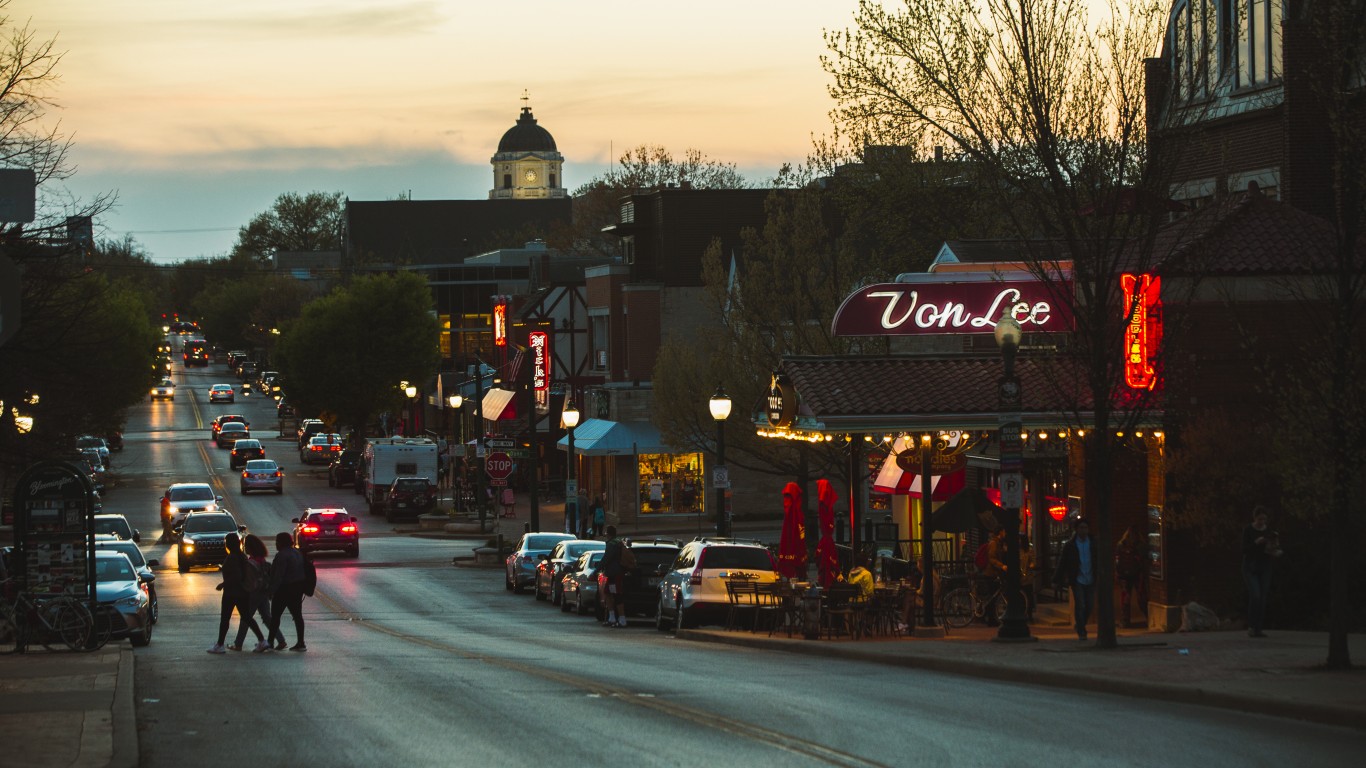
14. Indiana: Bloomington
> Population: 166,281
> Single population: 60.8% of total population
> Cost of living-adjusted income: $44,521 per capita
> Cost of living: 7.5% less than the national average
Located in south-central Indiana, Bloomington is another top performer for desirability as it offers a large overall population of adult unmarried residents. About 60.8% of the population is single, separated, divorced, or widowed, and about a quarter of the population lives alone. The cost of living in Bloomington is slightly higher than the state’s average but much lower than the national average. Residents may also have extra money for entertainment as just about a quarter of their income goes for housing.
[in-text-ad-2]
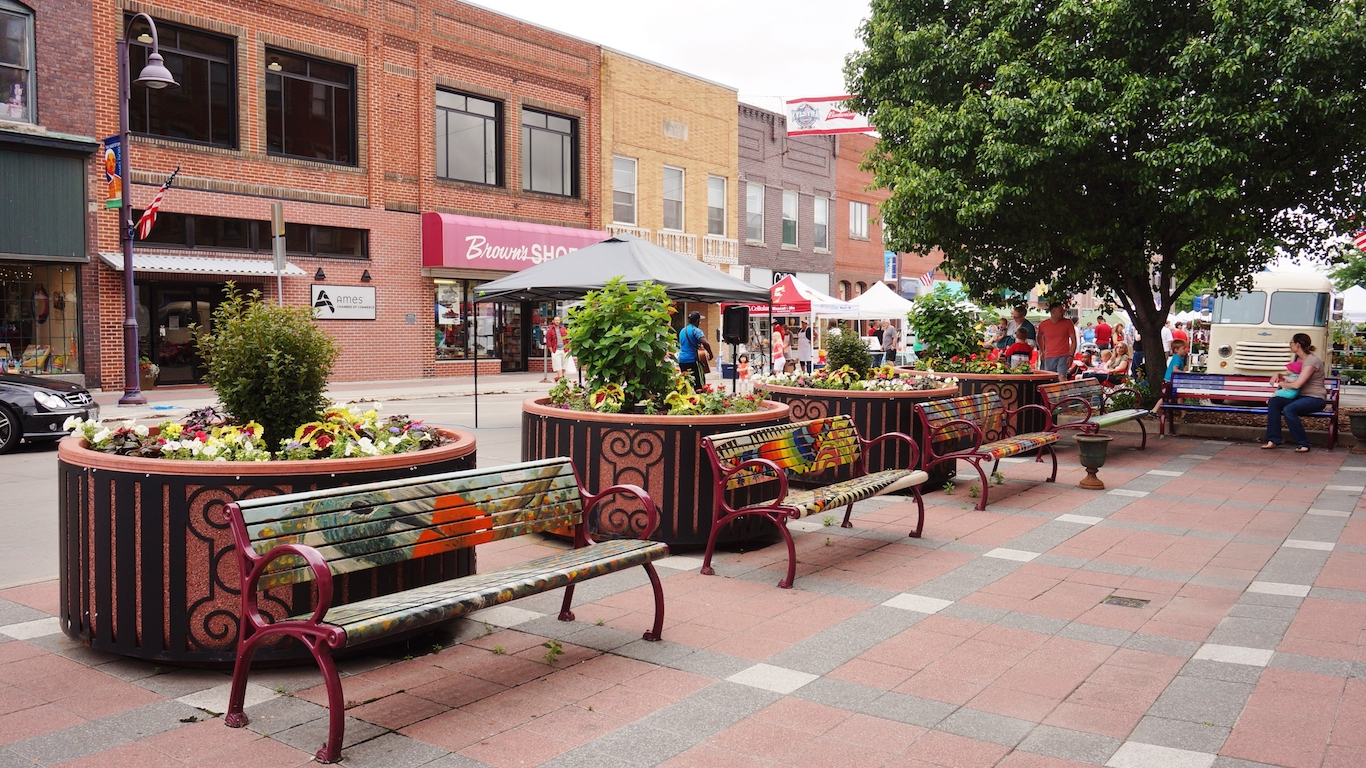
15. Iowa: Ames
> Population: 96,922
> Single population: 59.6% of total population
> Cost of living-adjusted income: $46,359 per capita
> Cost of living: 8.0% less than the national average
Ames, Iowa is not a major metro area, but it’s located near one — only about 35 miles from Des Moines in central Iowa. In addition to being close to a big city, unmarried residents of Ames may also benefit from a large share of fellow unmarried people living in the area. About 56.8% of the population is between 15 and 44 years old, a prime dating age. No other metro area has a higher share of residents in that age range. A big reason is that Ames is the location of Iowa State University. Both people looking for a relationship and those preferring to be alone benefit from having to pay much less than the national average for basic costs like housing and food.
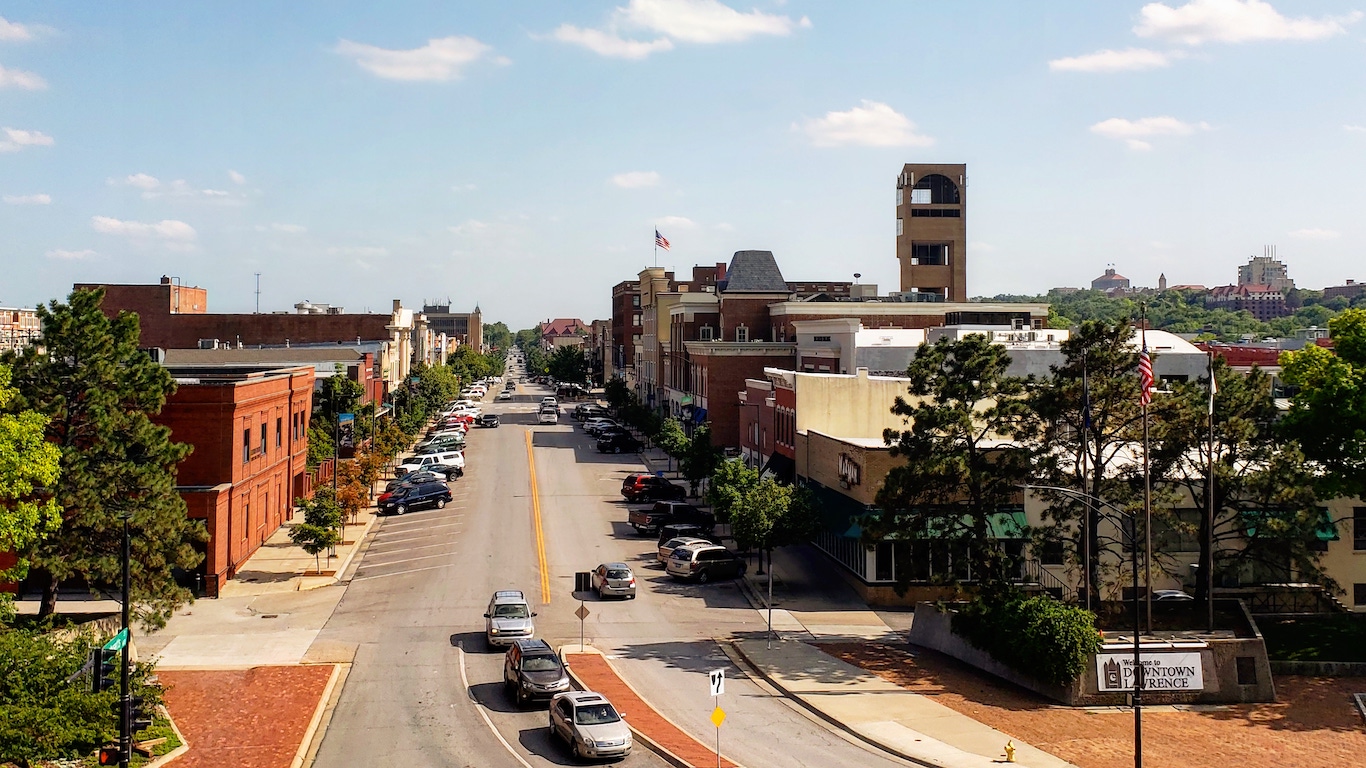
16. Kansas: Lawrence
> Population: 119,319
> Single population: 59.1% of total population
> Cost of living-adjusted income: $47,561 per capita
> Cost of living: 8.5% less than the national average
Lawrence is another example of a metro area that doesn’t have a very large population, though it is growing, and the majority of residents are not married. They also have many options for entertainment, whether on a date or by themselves. The concentration of movies, bars, and restaurants per 100,000 people is much higher in Lawrence than the state average.
[in-text-ad]

17. Kentucky: Lexington-Fayette
> Population: 506,786
> Single population: 53.3% of total population
> Cost of living-adjusted income: $53,010 per capita
> Cost of living: 8.8% less than the national average
Several factors help make the Lexington-Fayette metro area the best in the state for single people. It is one of the more populous areas in the state with over 506,000 residents, and more than half of the adult population is unmarried. The cost of living is much lower in the Lexington area than the national average, leaving residents with disposable income for recreational activities such as going to Bourbon County, the birthplace of bourbon whiskey.
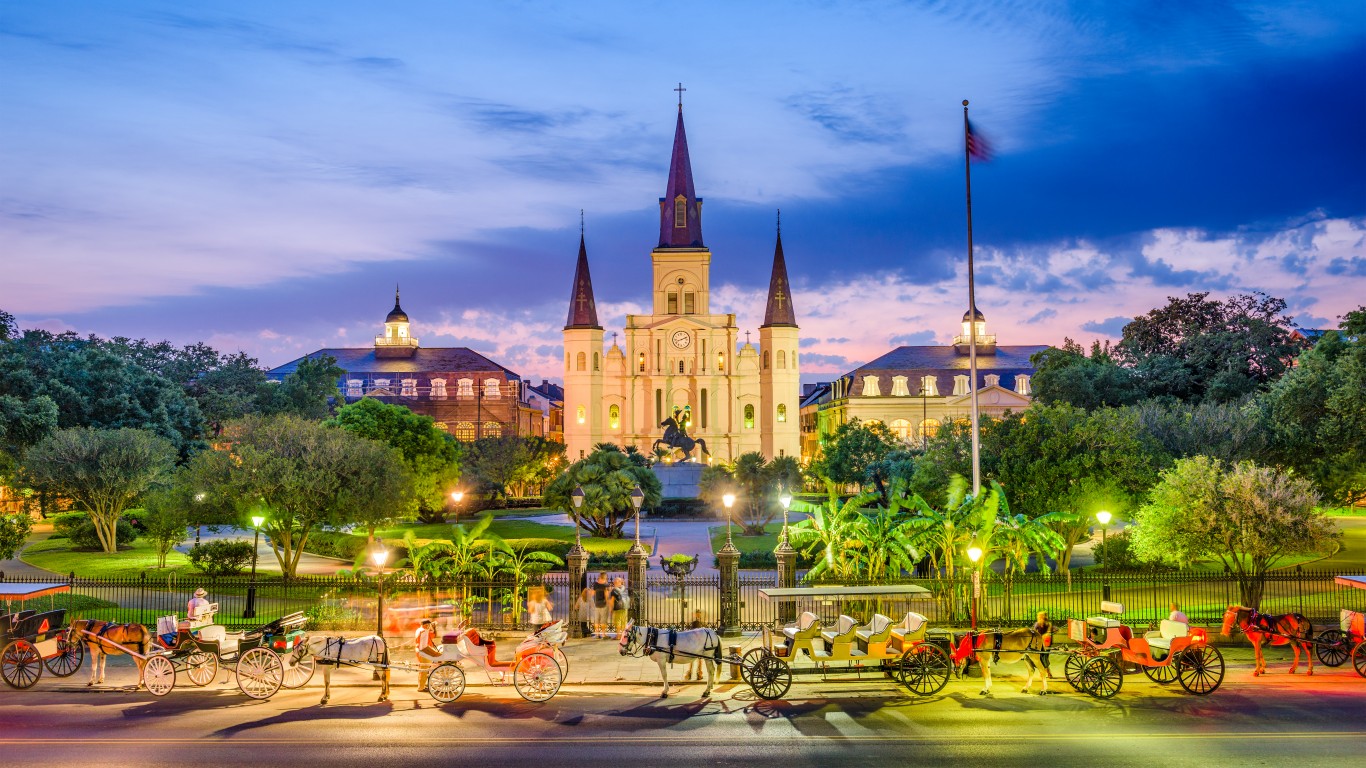
18. Louisiana: New Orleans-Metairie
> Population: 1,263,635
> Single population: 58.6% of total population
> Cost of living-adjusted income: $52,223 per capita
> Cost of living: 4.8% less than the national average
For many people, nightlife is a very important aspect of enjoying the single life — whether the idea is to find cool places to go on dates or have fun alone or with friends. The New Orleans metro area has an abundance of bars, restaurants, and music venues that offer entertainment for people during the day and the night. The large unmarried population in the metro area (58.6%) and the lower than average cost of living also contribute to the reasons the metro area is the best place for singles in Louisiana.

19. Maine: Bangor
> Population: 151,748
> Single population: 53.2% of total population
> Cost of living-adjusted income: $40,950 per capita
> Cost of living: 3.7% less than the national average
People moving to Bangor can enjoy a large pool of single friends and potential dates as 53.2% of the adult population is also single, or divorced, separated, widowed, or never married. The area also benefits from having a lower cost of living than both the state and national averages. A posible cool date idea is visiting the house of Bangor’s most famous resident, horror author Stephen King.
[in-text-ad-2]
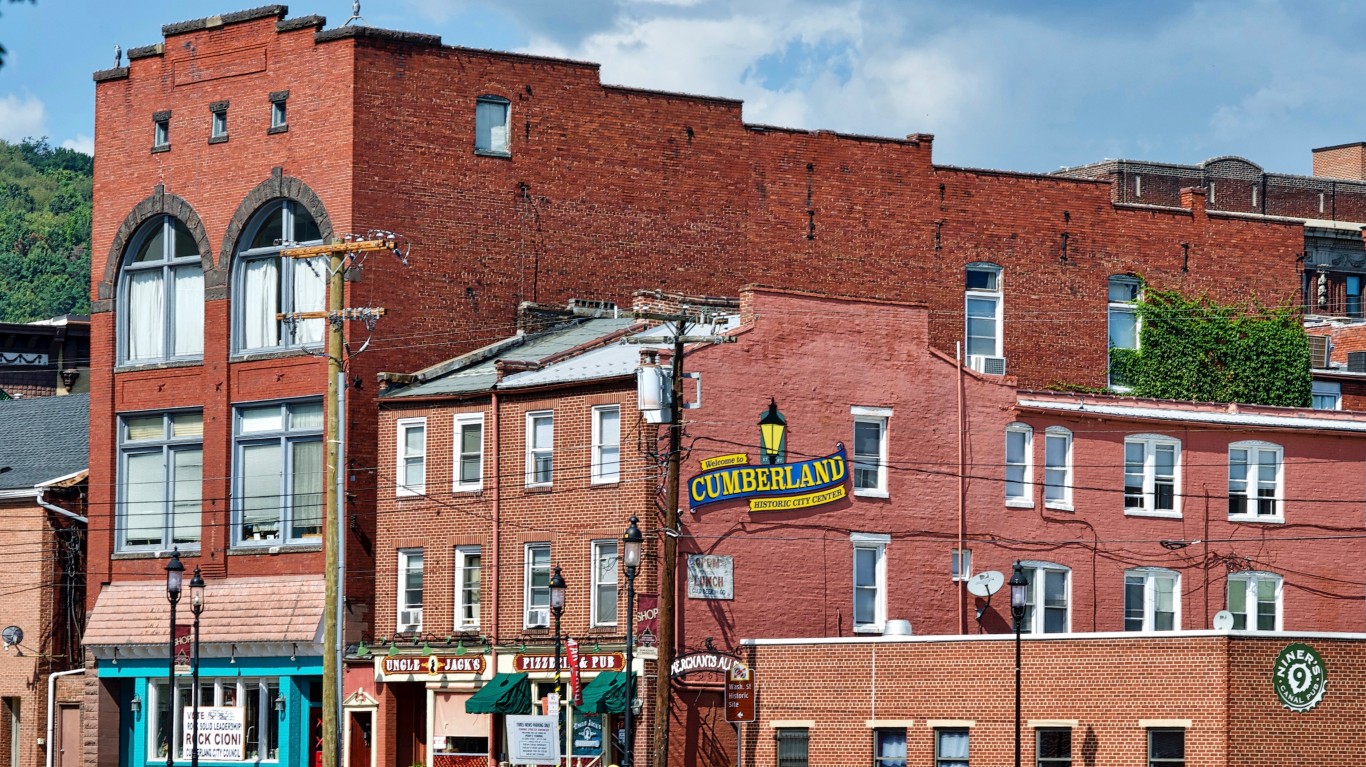
20. Maryland: Cumberland
> Population: 99,255
> Single population: 54.1% of total population
> Cost of living-adjusted income: $48,472 per capita
> Cost of living: 13.3% less than the national average
No metropolitan area that was entirely in Maryland was a good enough place for single people. The Cumberland metropolitan statistical area spans both Allegany County, Maryland, and Mineral County, West Virginia. People planning to live alone in Cumberland will find plenty of fellow single householders as 26.9% of housing units are occupied by one person. They should be prepared to spend about a fifth of the area’s median household income on rent, leaving them plenty of income for fun activities.

21. Massachusetts: Pittsfield
> Population: 127,328
> Single population: 54.4% of total population
> Cost of living-adjusted income: $53,894 per capita
> Cost of living: 2.3% less than the national average
Even though the population of the Pittsfield metro area has declined slightly since 2010,the metro area still has a fairly large population of about 130,000 people, and the majority of the adult population is unmarried. Residents need about fifth of their annual income for housing costs, leaving them with a good amount of money for plenty of nights out. The options are plentiful as the concentration of bars and restaurants per 100,000 people in Pittsfield is much higher than the state’s average.
[in-text-ad]

22. Michigan: Ann Arbor
> Population: 365,961
> Single population: 56.0% of total population
> Cost of living-adjusted income: $52,083 per capita
> Cost of living: 1.7% greater than the national average
While Ann Arbor, home to the University of Michigan, is one of the more expensive places to live in Michigan as the cost of living there is slightly greater than the national average and much greater than the state’s average, the metro area’s population has increased significantly since 2010. Given that about 56.0% of the adult population is single, and that 22.7% are single-householders, locals have a growing number of fellow unmarried residents to socialize with.
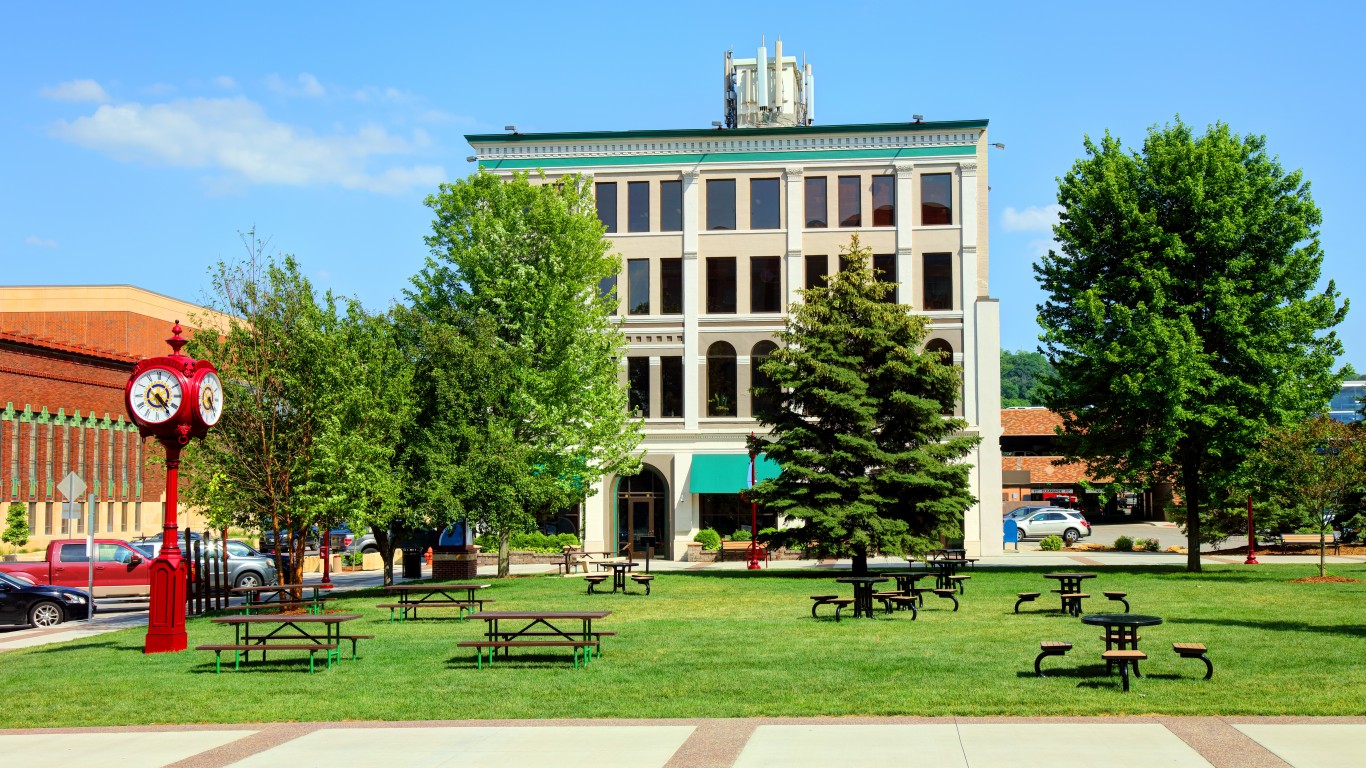
23. Minnesota: Mankato-North Mankato
> Population: 100,105
> Single population: 54.2% of total population
> Cost of living-adjusted income: $52,290 per capita
> Cost of living: 9.7% less than the national average
Even though the population in Mankato-North Mankato in south-central Minnesota has barely increased over the last few years, 54.2% of adults are unmarried or separated. The metro area offers some benefits that both single people and those in a relationship can enjoy, such as a much lower cost of living compared with both the national and the state averages as well as a higher concentration of museums, recreation facilities, bars, and restaurants compared with the rest of Minnesota.

24. Mississippi: Hattiesburg
> Population: 148,768
> Single population: 56.2% of total population
> Cost of living-adjusted income: $52,786 per capita
> Cost of living: 18.3% less than the national average
Hattiesburg is another metro area on our list where many people have moved to over the last decade. Hattiesburg may attract new residents for its significantly lower cost of living — 18.3% less than the national average. Only about a fifth of one’s annual income is spent on housing in the area, much less than the general rule of thumb of no more than 30%. There are plenty of places suitable for unmarried people to spend some of their remaining income, including bars, eating establishments, and fitness centers.
[in-text-ad-2]
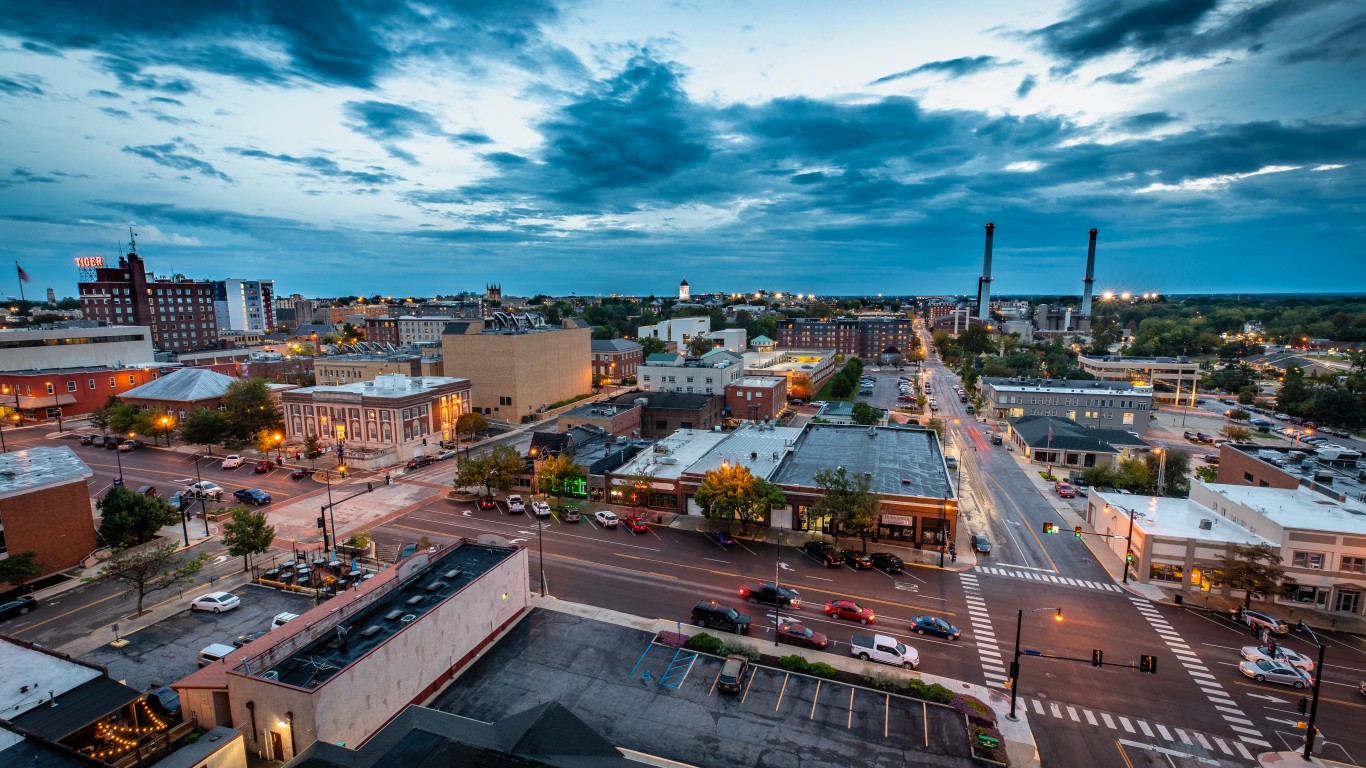
25. Missouri: Columbia
> Population: 176,515
> Single population: 55.5% of total population
> Cost of living-adjusted income: $52,303 per capita
> Cost of living: 9.7% less than the national average
The metro area — located near the Missouri River, Ozark Plateau, and the Northern Plains — attracts many people who love the outdoors. Whether you aim to be close to nature to enjoy it by yourself or with a date, you’ll meet a lot of fellow single adult residents — 55.5% of Columbia’s adult population is unmarried or separated. Columbia, home to the University of Missouri, takes the top spot for desirability in Missouri partly because of the low cost of basic needs like housing and food, which is significantly lower than the national average.
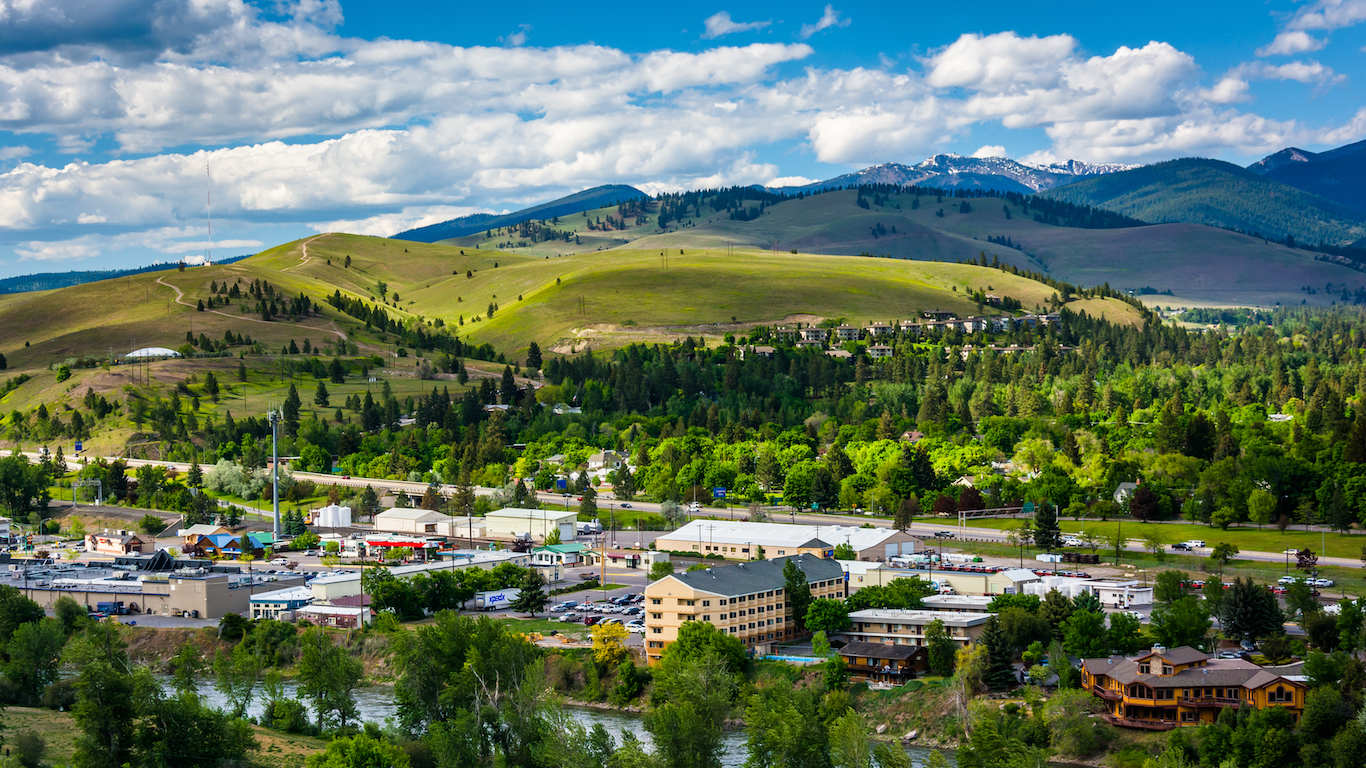
26. Montana: Missoula
> Population: 115,983
> Single population: 54.5% of total population
> Cost of living-adjusted income: $48,937 per capita
> Cost of living: 4.4% less than the national average
Like many of the nation’s urban areas in general and the best cities for single people in particular, Missoula is home to a major university. The University of Montana, based in the city, which has enrollment of more than 11,000, likely helps explain the city’s relatively large single population. Close to 55% of adults in the area have either never married, separated, divorced, or widowed — well above the national average percentage and the single populations of the Billings and Great Falls metro areas.
[in-text-ad]
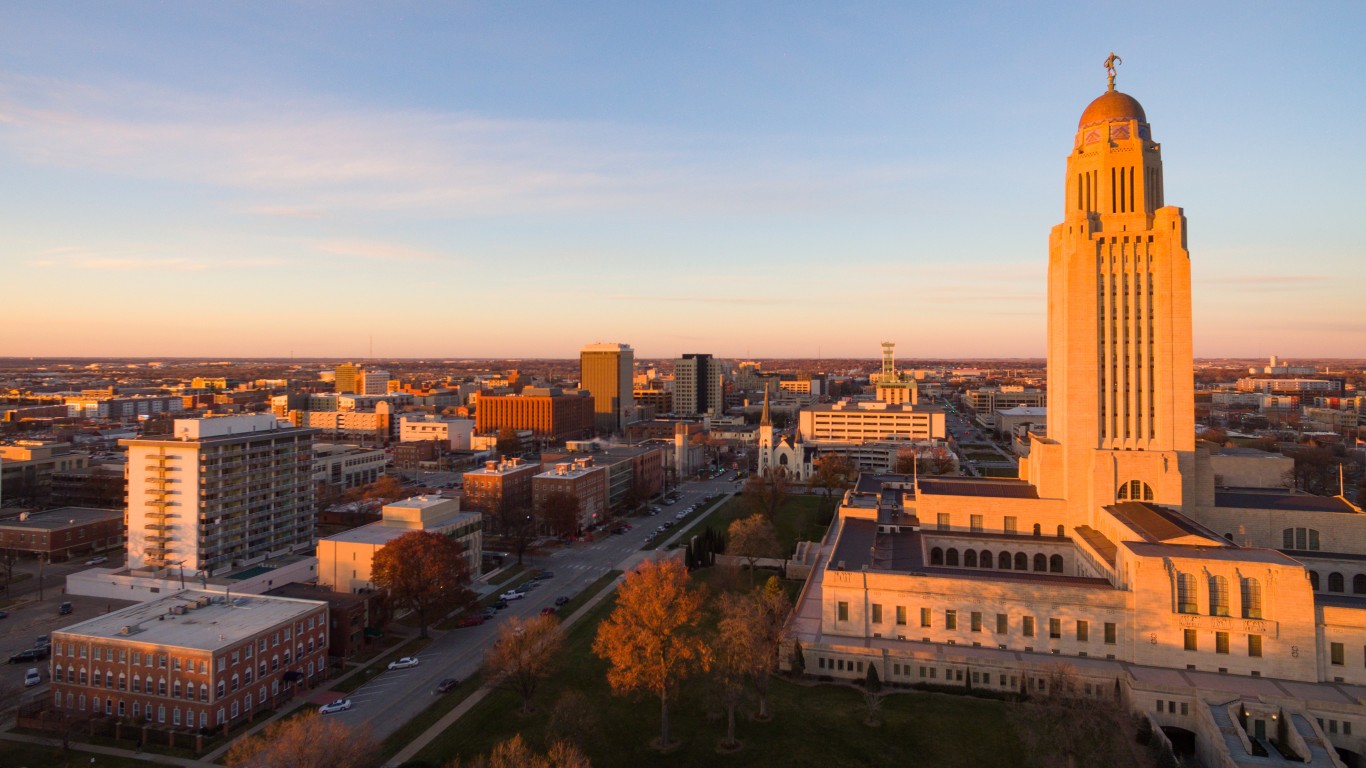
27. Nebraska: Lincoln
> Population: 327,221
> Single population: 52.3% of total population
> Cost of living-adjusted income: $53,975 per capita
> Cost of living: 8.5% less than the national average
The Lincoln metro area has a slim majority of single adult residents at 52.3%, but the population has been steadily increasing since the 1990s, providing an ever-growing pool of single people. Single, as well as married, residents benefit from a lower than the national average cost of living in Lincoln, where the University of Nebraska has its main campus. Housing costs require less than a fifth of one’s income, leaving a person with plenty of money for entertainment activities.
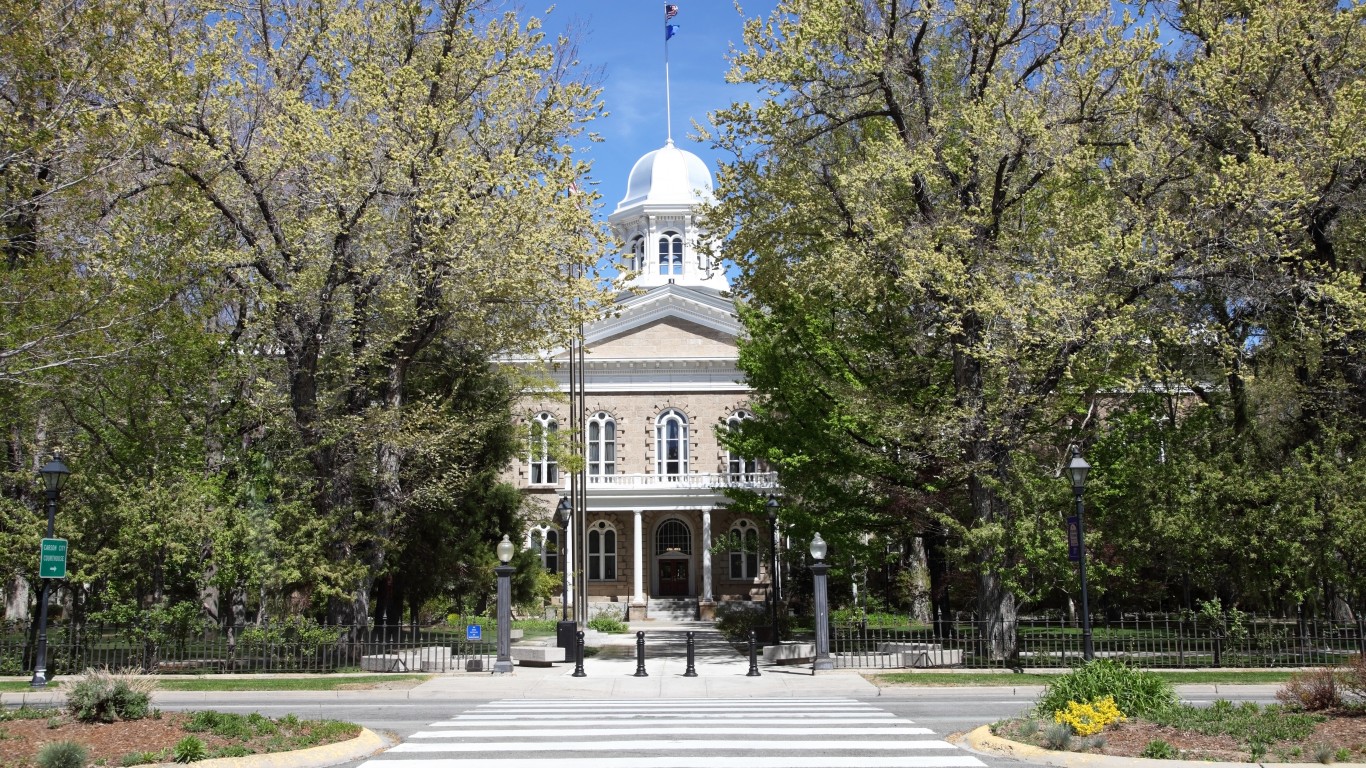
28. Nevada: Carson City
> Population: 54,467
> Single population: 54.2% of total population
> Cost of living-adjusted income: $49,454 per capita
> Cost of living: 3.9% less than the national average
While the cost of living is slightly lower than both the national and state averages in Carson City, only about a fifth of people’s income is needed for rent. Considering that the metro area’s location in the heart of Nevada and its proximity to Lake Tahoe, residents, whether looking to spend time alone or enjoy with friends, can afford to spend disposable income on outdoor adventures and other fun activities.
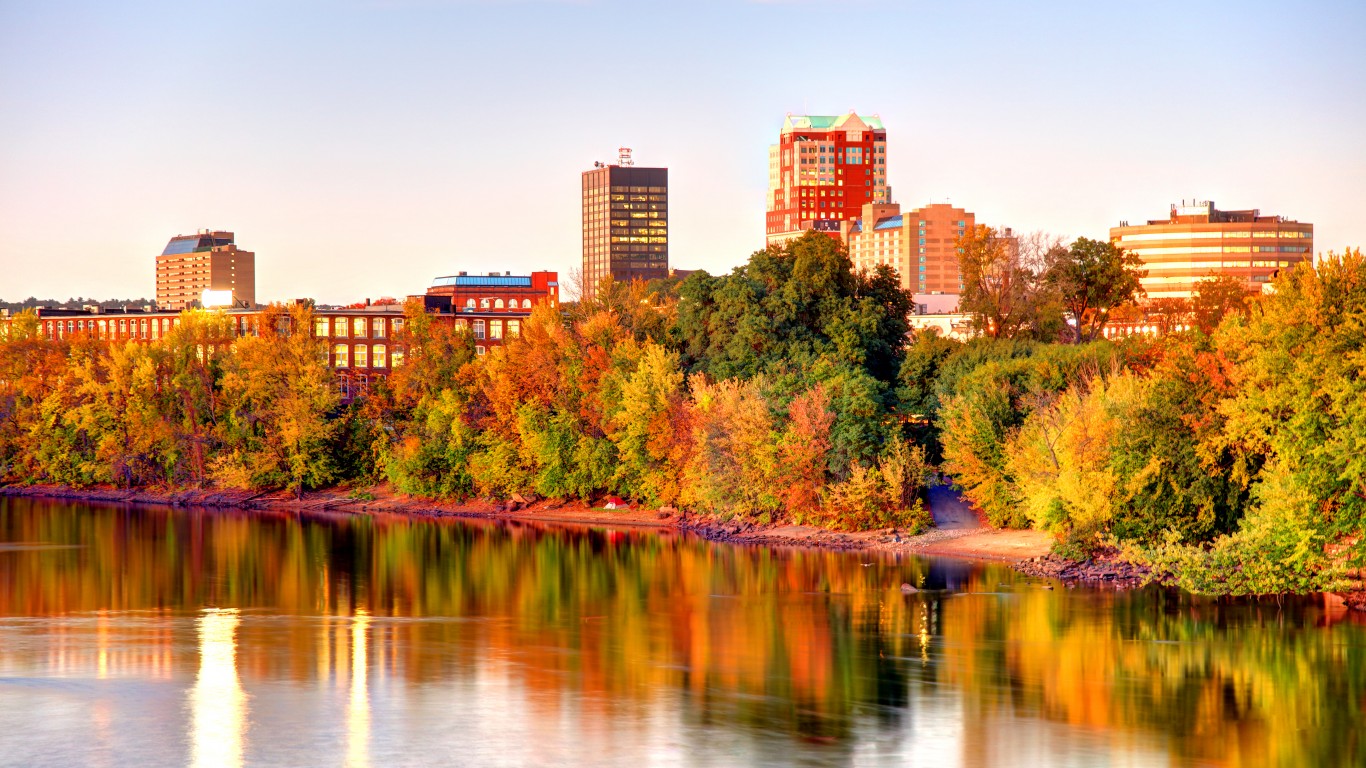
29. New Hampshire: Manchester-Nashua
> Population: 411,087
> Single population: 48.8% of total population
> Cost of living-adjusted income: $47,123 per capita
> Cost of living: 8.4% greater than the national average
As the only metro area in New Hampshire, the Manchester-Nashua area is the state’s best city for single people by default. While urban areas tend to have more vibrant dating scenes and are generally more supportive of financial independence, this is not especially the case in the Manchester area. A minority of adults are single, and the cost of living is relatively high.
On the other hand, the concentrations of certain amenities such as theater companies, venues to exercise and take fitness classes, as well as full-service restaurants are all higher in the Manchester area compared with the nation.
[in-text-ad-2]
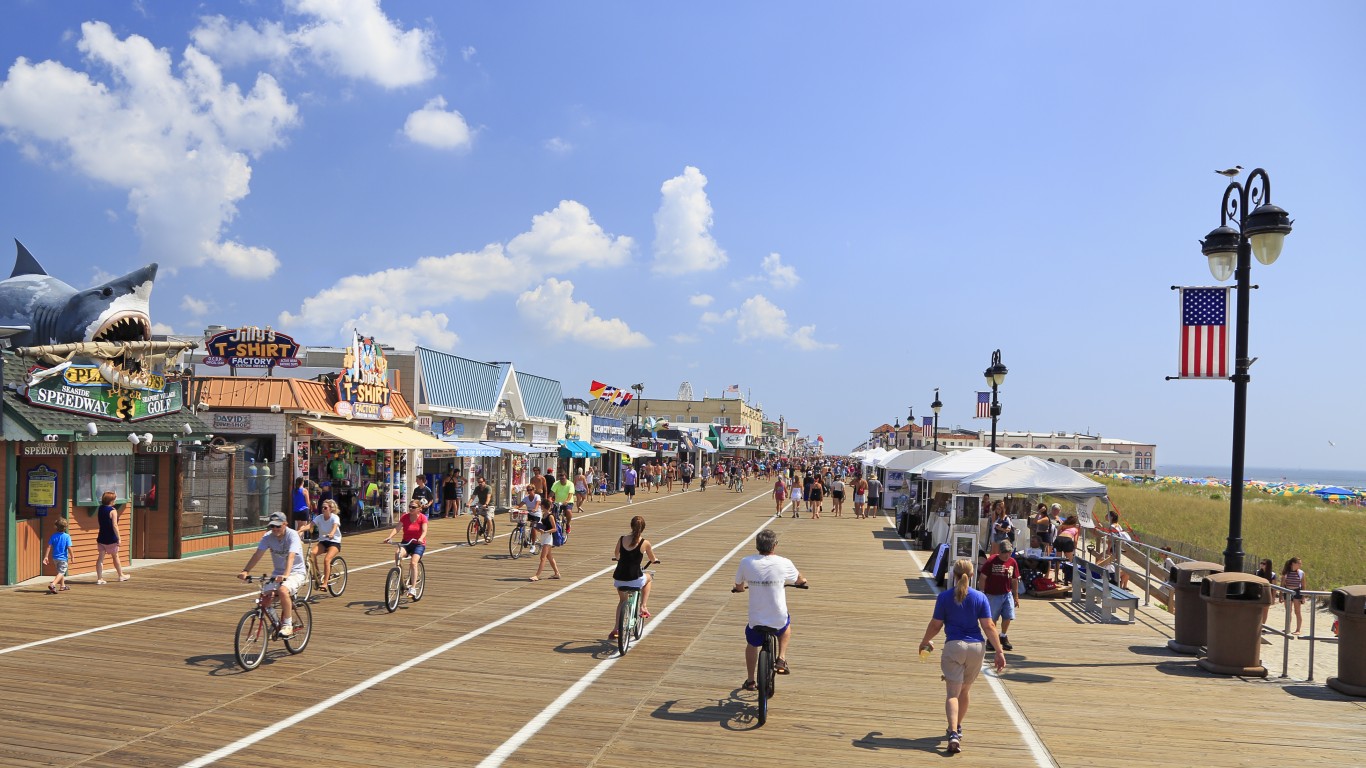
30. New Jersey: Ocean City
> Population: 93,705
> Single population: 45.4% of total population
> Cost of living-adjusted income: $50,440 per capita
> Cost of living: 4.5% greater than the national average
Ocean City, which bills itself as “America’s Greatest Family Resort,” is a dry town. This means no alcohol can be purchased within its borders, though alcohol can be consumed there. Just over 45% of the Jersey Shore resort town adult population is single, and the city has all the diversions of a seaside town — like boating, bike riding, seafood restaurants, shopping, and amusement parks — for residents to enjoy. The cost of a date is higher than the national average, and the average income is above the national average. The availability of fitness and sports facilities exceeds the national availability in Ocean City.

31. New Mexico: Santa Fe
> Population: 148,917
> Single population: 54.0% of total population
> Cost of living-adjusted income: $53,909 per capita
> Cost of living: 1.3% less than the national average
Compared to other cities in New Mexico, such as Albuquerque, Farmington, and Las Cruces, economic conditions are better in Santa Fe. Income per capita is higher than both the national and state figures , while the cost of living is a little lower. These factors can help singles in Santa Fe to more easily achieve financial independence.
Perhaps reflecting the degree of financial independence possible in the area, 30% of occupied housing units are one-person households, versus the national average percentage of 22.7%. It is also the highest percentage of one-person households of any city on this list.
[in-text-ad]

32. New York: Ithaca
> Population: 102,962
> Single population: 62.5% of total population
> Cost of living-adjusted income: $36,074 per capita
> Cost of living: 7.0% greater than the national average
Ithaca is the best city to be single in out of 12 metro areas in New York. Like many cities supporting a single lifestyle, Ithaca is home to several colleges and universities, including Cornell University. At 62.5% of the adult population, Ithaca has the second-largest single population in the nation after Gainsville, Florida. Roughly half of adults in Ithaca have never married.
These numbers may support a strong community for dating in Ithaca, but residents do not necessarily have the financial independence that residents in other cities on this list do. After adjusting for the area’s cost of living, at 7% greater than the national average, per capita income in the area is only $36,074.
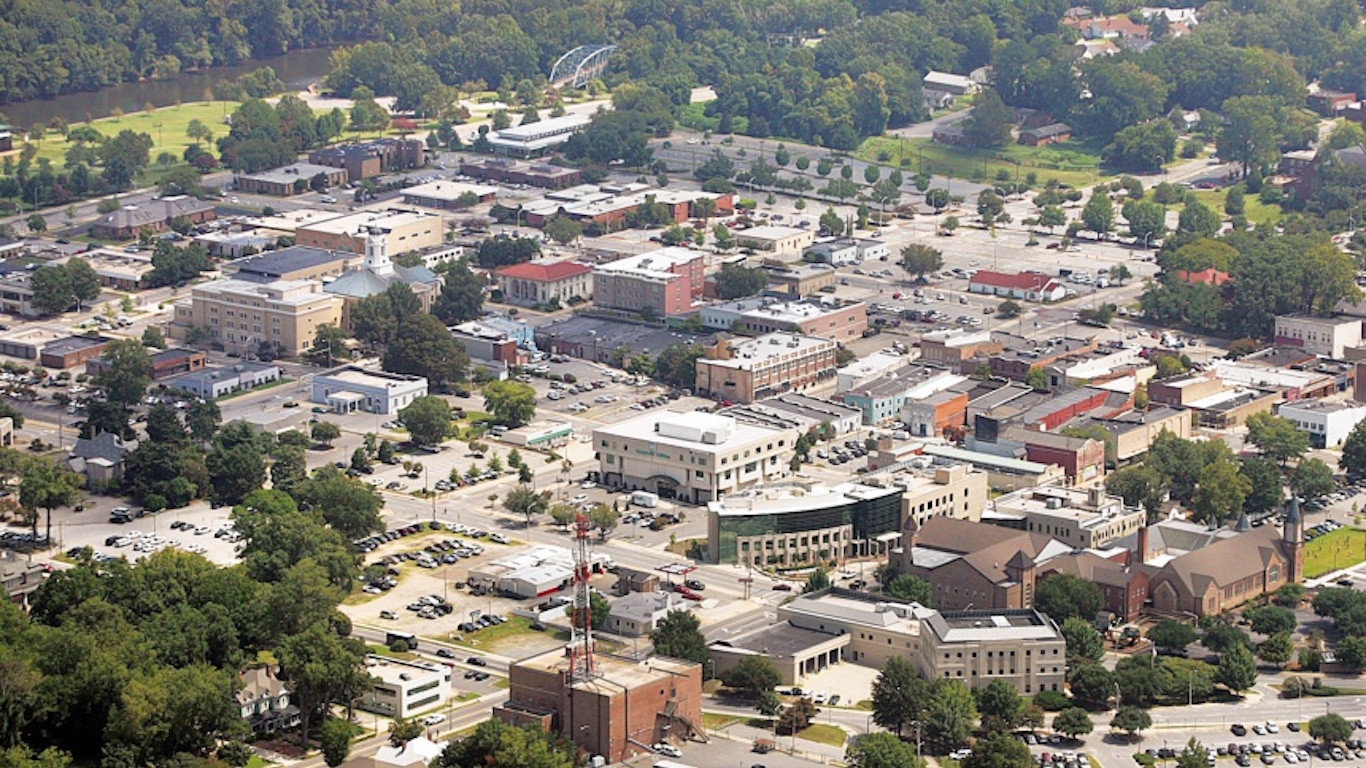
33. North Carolina: Greenville
> Population: 177,372
> Single population: 59.9% of total population
> Cost of living-adjusted income: $49,025 per capita
> Cost of living: 12.1% less than the national average
People who prefer a single lifestyle may like the Greenville metro area for financial reasons. The personal income per capita is higher than the national average, and the cost of living is lower than both the state and U.S. averages. The fact that about as much as 59.9% of the adult population is single, separated, or unmarried helps Greenville rank high on being a desirable city for singles.
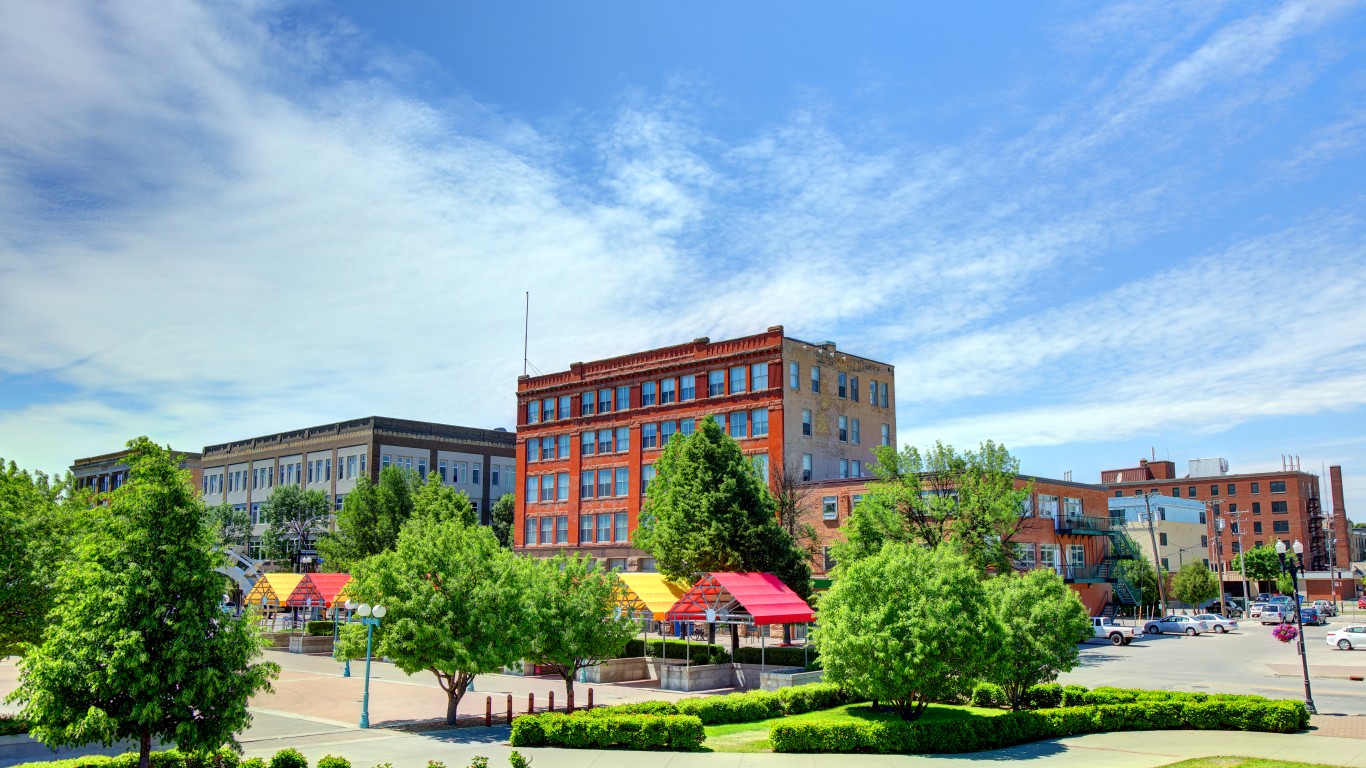
34. North Dakota: Grand Forks
> Population: 101,991
> Single population: 52.0% of total population
> Cost of living-adjusted income: $55,234 per capita
> Cost of living: 8.8% less than the national average
North Dakota has in the past decade experienced an oil boom. This has led to the creation of jobs for mostly young people in all sectors of the local economy. Among the cities that has benefited is Grand Forks, which sits on the border with Minnesota. The average monthly rent in Grand Forks is $799, just below the state average, and well below the national average of $1,023. With the average annual income for all workers at just over $55,000, singles, who comprise 52.0% of the adult population, have a lot of disposable income. Grand Forks is also home to the University of North Dakota.
[in-text-ad-2]
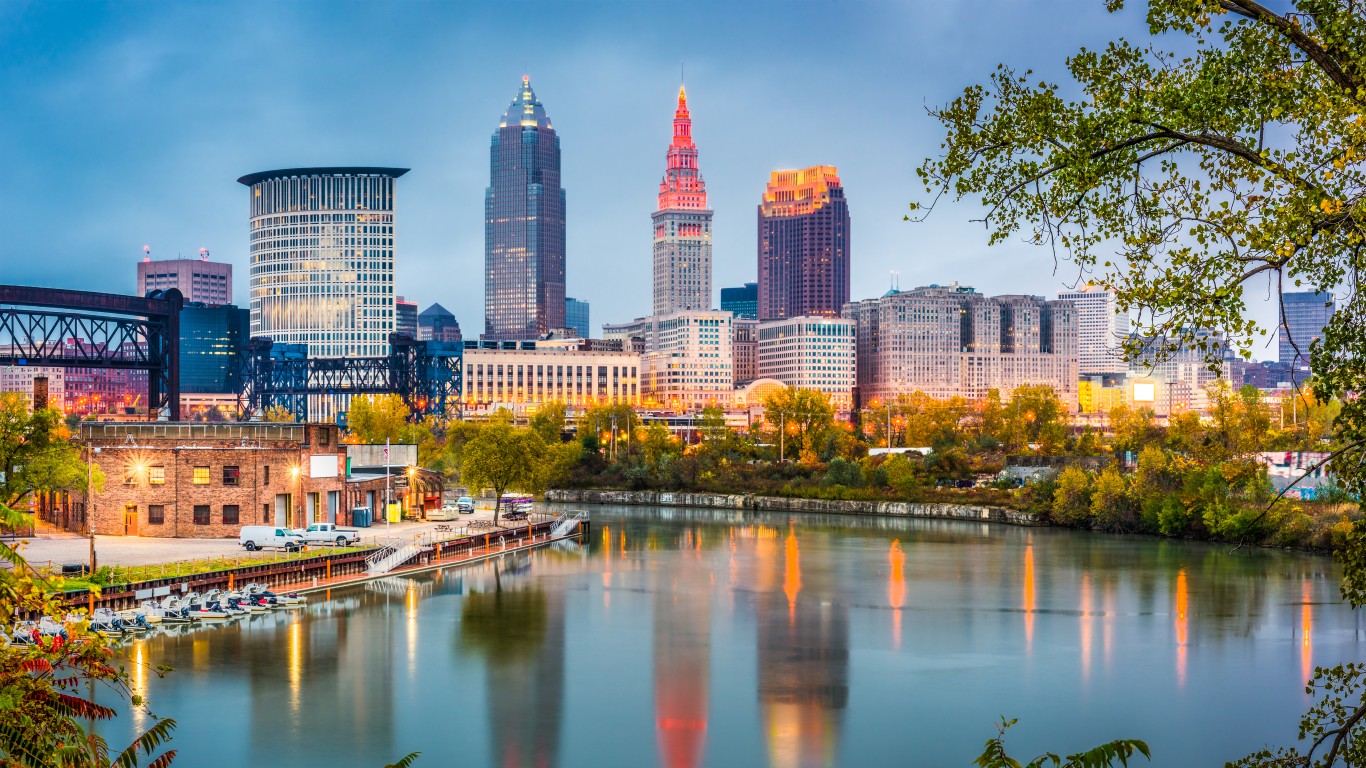
35. Ohio: Cleveland-Elyria
> Population: 2,061,766
> Single population: 55.0% of total population
> Cost of living-adjusted income: $60,025 per capita
> Cost of living: 9.8% less than the national average
The Cleveland metro area ranks as the best city for singles in Ohio largely due to economic reasons that help singles achieve financial independence. The personal income per capita is over $60,000, compared with a national average of nearly $49,000; the cost of living is 9.8% lower than the national average; and only about 18% of one’s income is required for housing. Additionally, 26.7% of occupied housing units in the metro area are single households, the third highest share of the 50 cities on the list.

36. Oklahoma: Lawton
> Population: 128,490
> Single population: 53.6% of total population
> Cost of living-adjusted income: $46,988 per capita
> Cost of living: 10.5% less than the national average
Lawton is in the southwestern part of Oklahoma, and its economy is dominated by the defense industry. It is home to the Fort Sill Military Reservation. Recreational opportunities for singles include outdoor sports activities. There are three lakes in the region:Lake Lawtonka, Lake Ellsworth, and Elmer Thomas Lake. An estimated 25.2% of housing units are occupied by one person, above the national average of 22.7%. Only about 21% of one’s income is required for housing in Lawton, leaving more disposable income for savings and activities.
[in-text-ad]
37. Oregon: Corvallis
> Population: 89,780
> Single population: 55.3% of total population
> Cost of living-adjusted income: $41,809 per capita
> Cost of living: 0.6% greater than the national average
The Corvallis metro area, located in Willamette Valley in north-central Oregon, is the best place for single people in the state not so much for economic reasons but for demographic. The personal income per capita is lower than the national average and the cost of living is about the same as the U.S. average. However, 83.5% of the total population is 18 years or over, a prime age for dating. This is the second highest share of all 50 metro areas on our list, and among that population, unmarried people are in the majority.
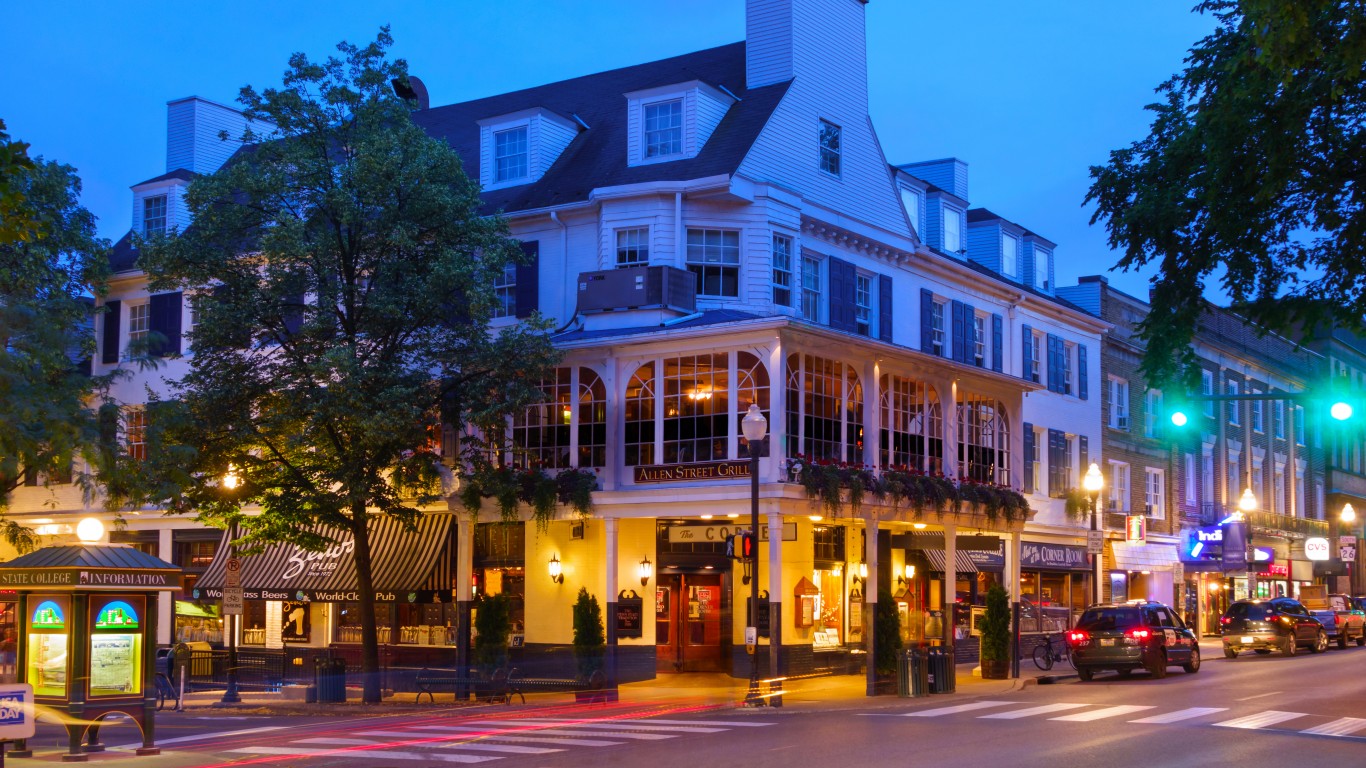
38. Pennsylvania: State College
> Population: 161,443
> Single population: 58.7% of total population
> Cost of living-adjusted income: $40,029 per capita
> Cost of living: 2.8% greater than the national average
State College, Pennsylvania, is home to the main campus of Penn State University, one of the premier public universities in the nation. Not surprisingly, almost 60% of the adult population is single, well above the national average of 51.9%, and the percentage of those between 15 and 44 years old at 51.6%, one of the highest percentages of any city on the list. More than 84% of the population is over 18 years old. Because of the presence of the university, much of the night life and leisure activity revolves around Penn State, such as Palmer Museum of Art and Penn State Centre Stage. Pubs and sports bars are a big part of the night life in State College.
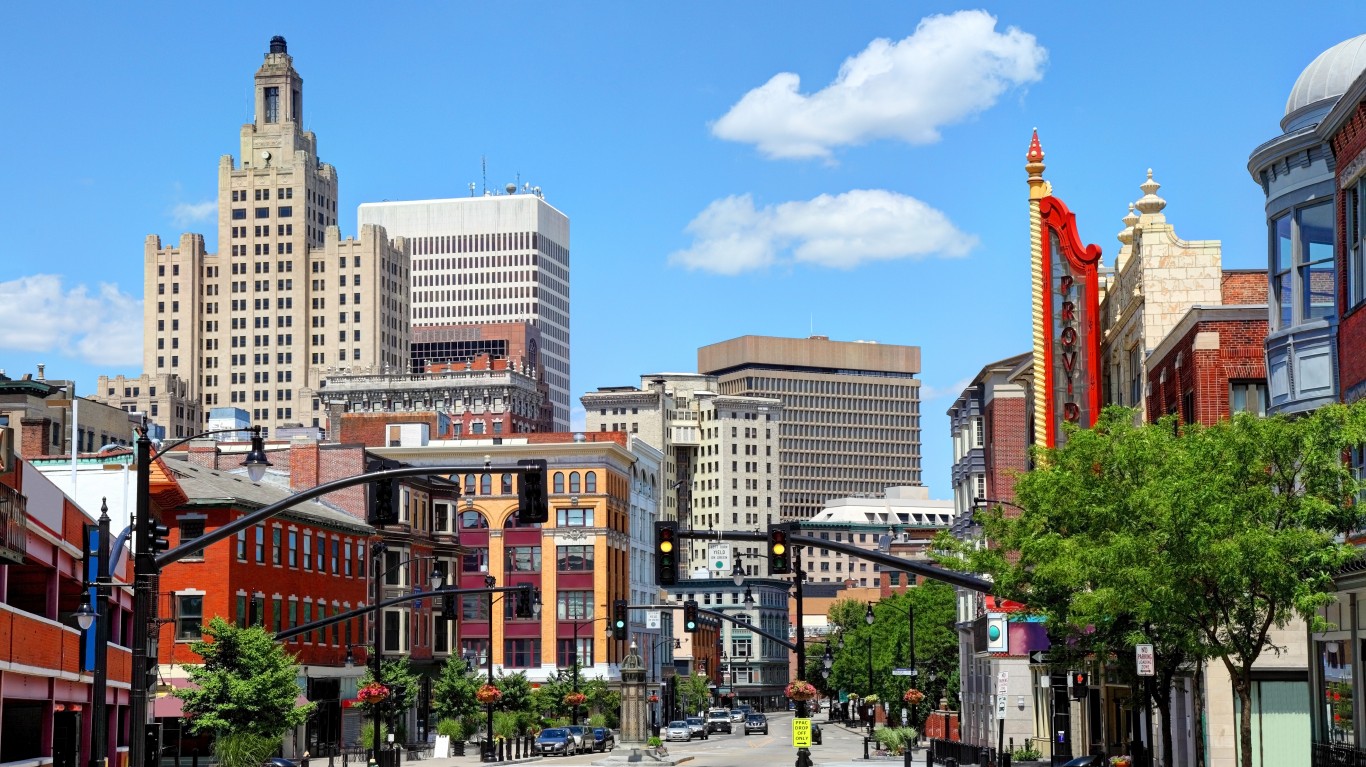
39. Rhode Island: Providence-Warwick
> Population: 1,615,516
> Single population: 54.6% of total population
> Cost of living-adjusted income: $49,832 per capita
> Cost of living: 0.3% less than the national average
The Providence metro area, which comprises eight counties in Rhode Islands and Massachusetts, is the second most populous on the list. The metro area is more populous than Rhode Island itself, which has slightly over a million residents. About 54.6% of the adult population is unmarried or separated. The metro area is home to the University of Rhode Island and is close to other regions with major universities.
[in-text-ad-2]

40. South Carolina: Florence
> Population: 205,814
> Single population: 56.3% of total population
> Cost of living-adjusted income: $49,506 per capita
> Cost of living: 13.9% less than the national average
Florence is located in the eastern part of South Carolina, and 56.3% of the city’s population is single, one of the highest percentages of any city on the list. The cost of living in Florence is almost 14% less than the national average. Just about a fifth of annual income is needed for housing. Among the diversions for singles in Florence are the Florence Little Theatre and the Florence Trails System that connects 45 miles of trails. The city also hosts a First Fridays event each month that includes a free concert downtown.

41. South Dakota: Sioux Falls
> Population: 255,438
> Single population: 47.1% of total population
> Cost of living-adjusted income: $64,852 per capita
> Cost of living: 8.4% less than the national average
Singles in Sioux Falls, the biggest city in South Dakota, enjoy a cost of living more than 8% below the national average. The average annual income for all workers is $64,852, almost $16,000 higher than the national average. Also, only about 15% of income is needed for housing costs. This provides for considerable disposable income that can be spent on diversions in Sioux Falls such as the Falls Park and the SculptureWalk & The Arc of Dreams.
[in-text-ad]

42. Tennessee: Memphis
> Population: 1,345,991
> Single population: 57.9% of total population
> Cost of living-adjusted income: $51,125 per capita
> Cost of living: 8.9% less than the national average
Memphis is one of five cities on the list with a population of more than 1 million people. The cost of living in Memphis is almost 9% below the national average. The single population comprises 57.9% of the city’s adult population, well above the national average. There are plenty of attractions for singles in Memphis, starting with a tour of Elvis Presley’s Graceland home. Beale Street, “home of the blues,” is where the Memphis Rock ‘n’ Soul Museum is located. For sports activities, a date night might be watching the NBA’s Memphis Grizzlies.

43. Texas: Midland
> Population: 169,808
> Single population: 47.0% of total population
> Cost of living-adjusted income: $102,596 per capita
> Cost of living: 0.3% greater than the national average
> Average cost of a date in Texas: $99.60
In the Midland metro area, a major oil industry hub, the personal income per capita is more than double the national income, at $102,904 and $48,980, respectively. People who prefer the single life have a considerable amount of disposable income for entertainment, savings, or expenses. This contributes to Midland’s rank as the best metro area in Texas for single people despite the fact that slightly less than half of the adult population is unmarried or separated.
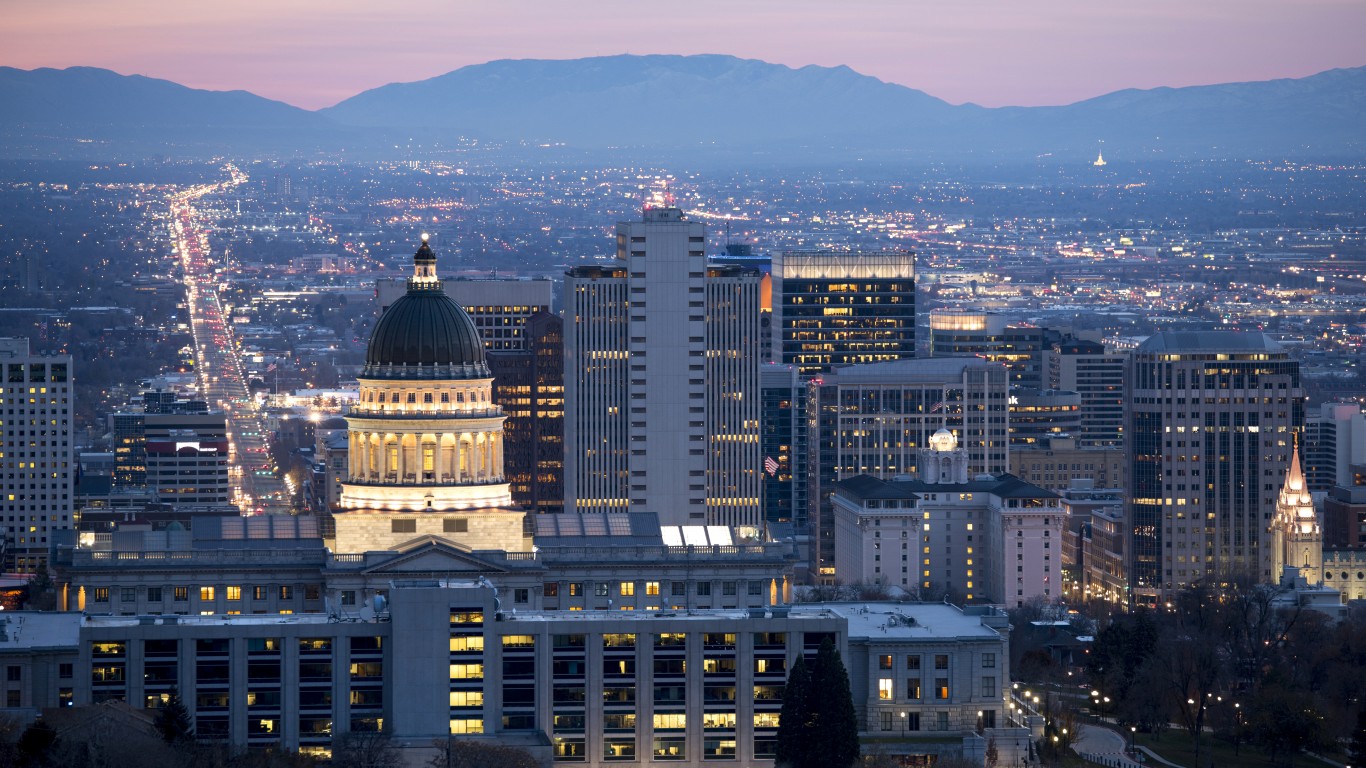
44. Utah: Salt Lake City
> Population: 1,185,990
> Single population: 47.8% of total population
> Cost of living-adjusted income: $47,430 per capita
> Cost of living: 0.9% less than the national average
Salt Lake City has the lowest percentage of one-person households of any city on the list at 17.7%, not surprising since the cost of rent is $1,062, just above the national average. Salt Lake City has about 13 institutions of higher learning, including the University of Utah, so students and alumni comprise a major portion of the population. Utah overhauled its liquor laws about 10 years ago, relaxing the requirements to open bars. A date in Salt Lake City might involve the outdoors, and Utah is known for its parks, among them Arches, Bryce, and Zion. Skiing and ice skating are popular winter activities in Salt Lake City.
[in-text-ad-2]
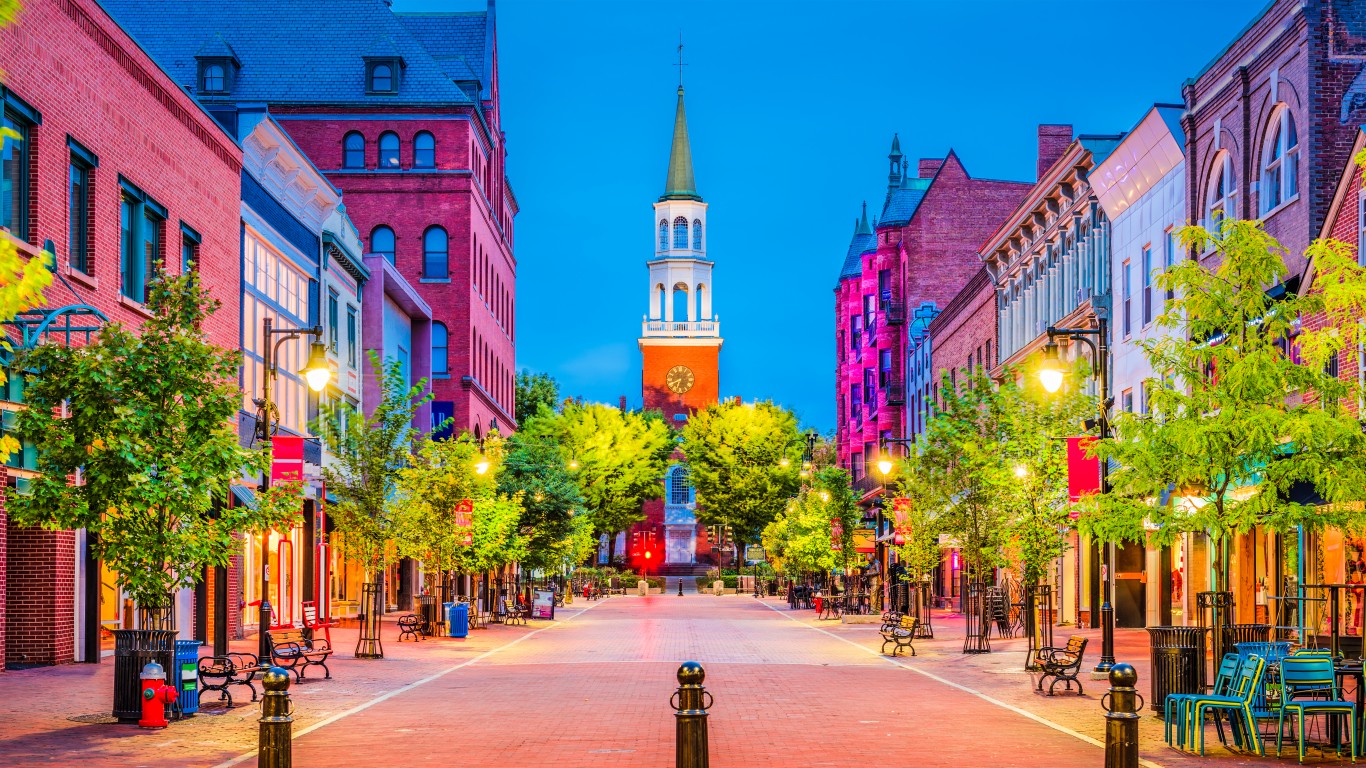
45. Vermont: Burlington-South Burlington
> Population: 218,042
> Single population: 52.3% of total population
> Cost of living-adjusted income: $47,778 per capita
> Cost of living: 5.0% greater than the national average
The Burlington-South Burlington metro area is the only metropolitan statistical area in Vermont, so by default it is the best city for singles in the state. Even though the region has a slim majority of single adult residents, the overall population has been steadily increasing for many years.

46. Virginia: Charlottesville
> Population: 230,905
> Single population: 52.6% of total population
> Cost of living-adjusted income: $62,338 per capita
> Cost of living: 1.8% less than the national average
Charlottesville, a metro area probably best known for being home to the University of Virginia, is also a popular destination for nature and history fans. Bars, restaurants, historical sites, amusement and recreational facilities, and museums are more concentrated in the Charlottesville metro area than the state as a whole, providing plenty of options for entertainment. The personal income per capita in the metro area is much higher than the national average, while the cost of living is about the same, suggesting that locals have the financial stability to support a lifestyle as a single person.
[in-text-ad]

47. Washington: Bellingham
> Population: 216,812
> Single population: 52.6% of total population
> Cost of living-adjusted income: $45,477 per capita
> Cost of living: 1.2% less than the national average
With more options for dating and opportunities to meet new friends, as well as economic conditions favorable to financial independence, Bellingham is the best place to be single of the 11 metro areas in Washington.
Restaurants, bars, and places for entertainment such as bowling alleys, are all more prevalent in the city than elsewhere in the state and compared to the nation as a whole. The area’s relatively low cost of living helps offset the below-average income for the area.
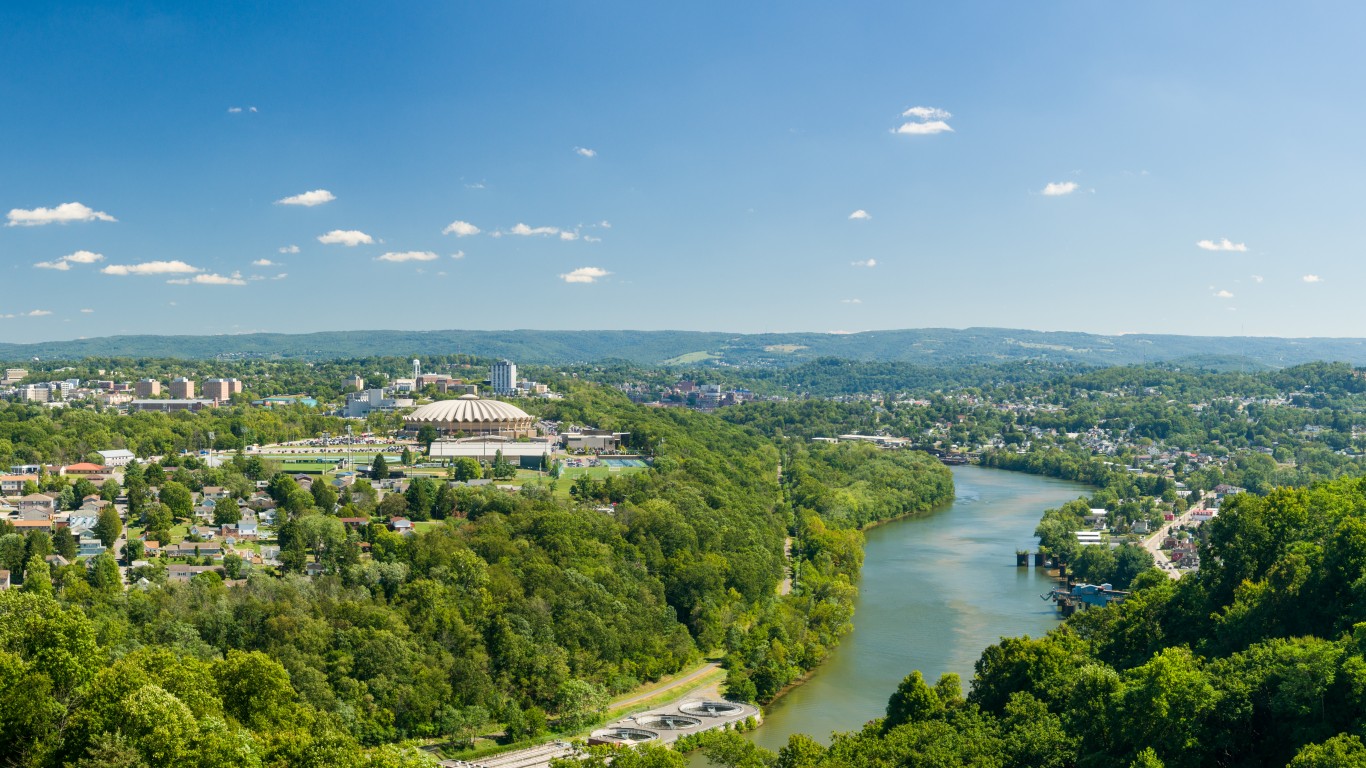
48. West Virginia: Morgantown
> Population: 139,089
> Single population: 58.7% of total population
> Cost of living-adjusted income: $47,034 per capita
> Cost of living: 9.3% less than the national average
Morgantown is the best city to be single in West Virginia. The metro area has a large overall population and a large share of single residents, with 58.7% of the adult population unmarried or separated. The north-central West Virginia metro area does not appear to be pricey, as the cost of living is 9.3% less than the national average and only about a fifth of one’s personal income is needed for housing costs.
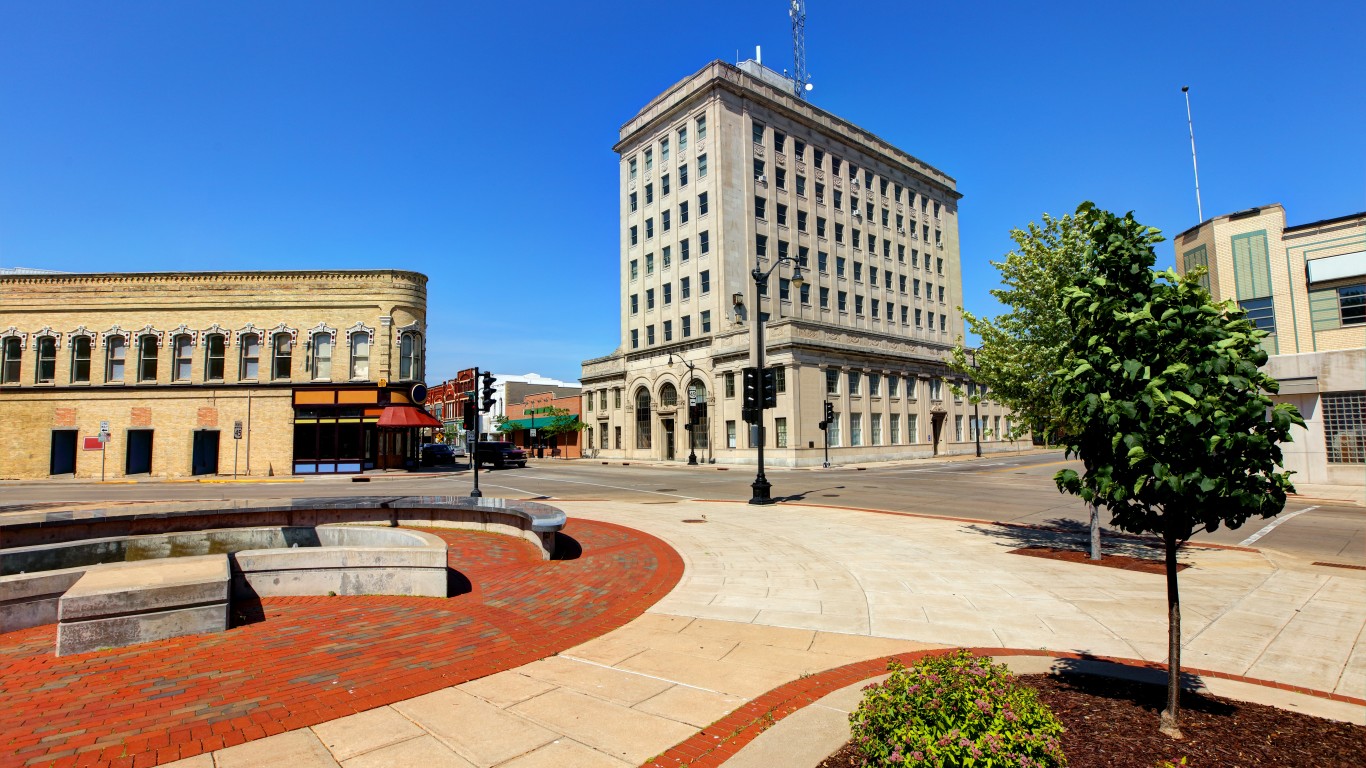
49. Wisconsin: Oshkosh-Neenah
> Population: 169,926
> Single population: 52.0% of total population
> Cost of living-adjusted income: $53,844 per capita
> Cost of living: 9.8% less than the national average
The Oshkosh-Neenah metro area has enjoyed a population growth since 2010, and 52.0% of the area’s adults residents are unmarried or separated. People who prefer to be single may be attracted to the region because they can more easily achieve financial independence there. The cost of living is lower in the metro area than both the state and national averages.
[in-text-ad-2]
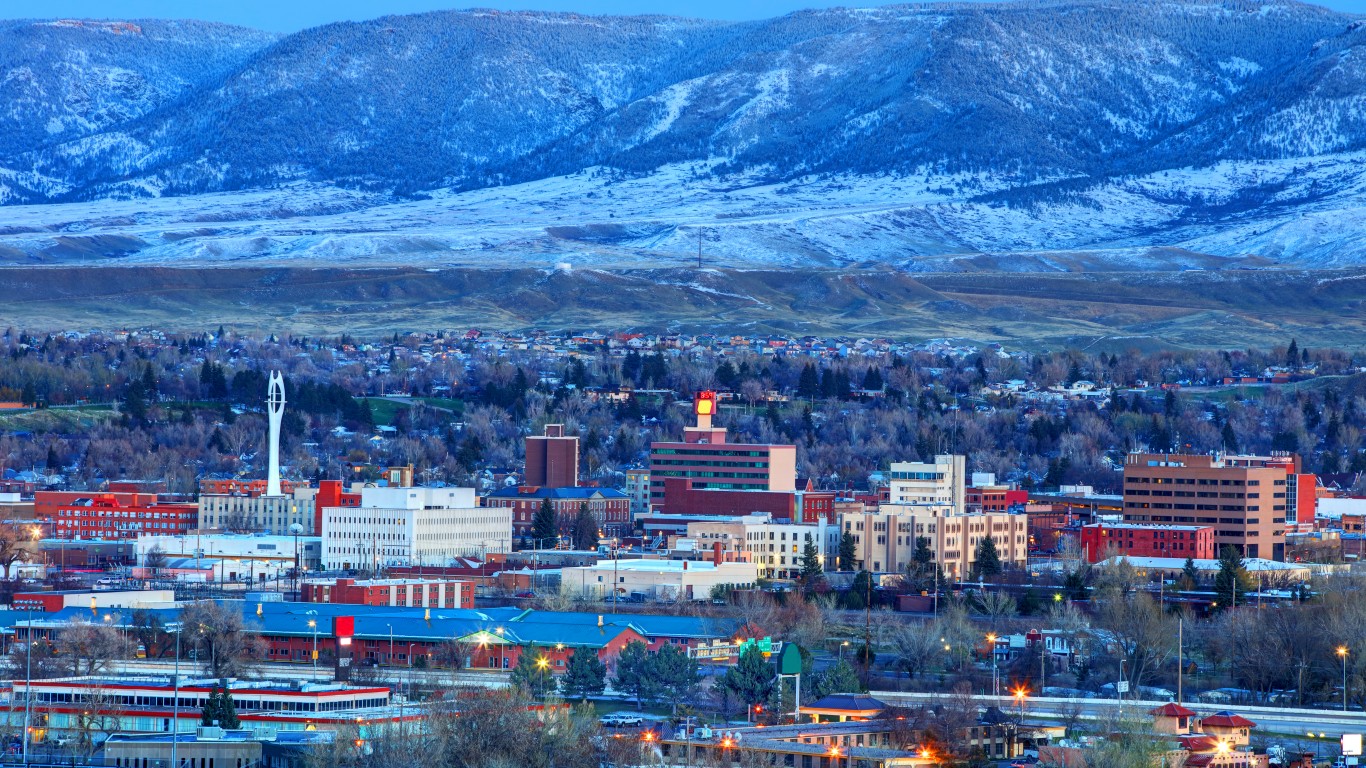
50. Wyoming: Casper
> Population: 80,610
> Single population: 49.8% of total population
> Cost of living-adjusted income: $64,283 per capita
> Cost of living: 3.7% less than the national average
The Casper metro area, while outranking the only other metro in the state, is also one of the best places in the nation to be single. Average income after adjusting for the city’s relatively low cost of living is the eighth highest of all metro areas — $64,283 per capita. The typical monthly rent in Casper is $867, in line with what renters usually pay across the state and well below the median for the nation. Casper’s poverty rate of less than 10% is one of the lowest in the country.
While more adults nationwide are unmarried or separated than in Casper, area residents enjoy relatively high concentrations of amenities that may help support dating and opportunities for meeting people. For example, the numbers of restaurants and bars as well as sports and fitness recreation centers per capita in Casper are well above the prevalence of these establishments across the nation.
Methodology:
To identify the best cities to be single in the United States, 24/7 Tempo created an index of a variety of data on attributes that would lend themselves to a desirable environment for single people. Data is on the metropolitan statistical area (MSA) level. Raw data was indexed using min-max normalization, and MSAs were ranked based on the given composite score.
The first aspect of the index is the percentage of the population 15 years and older who are currently single (those classified as widowed, divorced, never married, or separated). Data on the single and married populations, as well as median household income, average gross rent, total population breakouts, and the percentage of households owned by a single person, all were derived from the U.S. Census Bureau’s American Community Survey (ACS) 2018 5-Year Estimates.
We also considered the 2017 real personal income (RPI) per capita as part of the index as a measure of affordability relative to other MSAs. RPI was then adjusted for relative cost of living using the regional price parity (RPP) for each MSA. RPI and the RPP for 2017 came from the Bureau of Economic Analysis.
The number of date-friendly institutions per 100,000 of the total population was incorporated into our final rank. These include, but are not limited to: theaters, fitness and recreational sports centers, full service restaurants, museums, bars, nature parks, and zoos. The number of establishments in each MSA that fit the criteria came from the U.S. Census Bureau’s County Business Patterns for 2017, and was then adjusted per 100,000 using the 2017 1-year total population from the ACS.
Finally, the average cost of a date in each state was derived from an index 24/7 Wall St. created for the story The Average Cost of a Date in Each State, published in August of 2019.
Retirement planning doesn’t have to feel overwhelming. The key is finding professional guidance—and we’ve made it easier than ever for you to connect with the right financial advisor for your unique needs.
Here’s how it works:
1️ Answer a Few Simple Questions
Tell us a bit about your goals and preferences—it only takes a few minutes!
2️ Get Your Top Advisor Matches
This tool matches you with qualified advisors who specialize in helping people like you achieve financial success.
3️ Choose Your Best Fit
Review their profiles, schedule an introductory meeting, and select the advisor who feels right for you.
Why wait? Start building the retirement you’ve always dreamed of. Click here to get started today!
Thank you for reading! Have some feedback for us?
Contact the 24/7 Wall St. editorial team.